WRVA Old Dominion Barn Dance
Documenting the history of the WRVA Old Dominion Barn Dance and its
iterations over the years includes some challenges. One is the history
of the radio station from its inception. A second is how the show itself
evolved over the years from "WRVA Barn Dance" to the name that
became known and finally the "New Dominion Barn Dance" when it finally
ended. But the main thrust will be the time period (Or should we
consider it an 'era'?) when Sunshine Sue (Workman) was the "femcee"
of the show and helped manage the roster. Then there is the venue where
the show broadcast from - the studio, the Mosque Theater, the Lyric Theater
that was later leased by WRVA and renamed the WRVA Theater as well as other places
such as the Venus Theatre, John Marshall Hotel when the WRVA Theater was booked. Over the years,
the reader will see that many country music legends graced the stage of this show.
The Radio Station — WRVA
The station was created and put on the air by the Larus and Brother Tobacco Company
and began operating as the "House of Edgeworth". The call letters were seen
as a short abbreviation for Richmond, Virginia - WRVA.
Local Richmond newspapers in the mid-1920's covered the development of the new radio
station, often with front page stories. The station's first day of broadcast
was at 9:00pm on November 2, 1925. The News Leader (Staunton, Virginia) reported on
November 1 that the station was the best of its time and would have an initial
power of 2,000 watts. It was to be broadcast on a wave length of 256 meters (1170AM).
The first week on the air, WRVA was only on the air on Monday night and
Thursday night, with special ("elaborate") programs.
Already on the air by WRVA's November 1925 debut were such well known stations as KDKA in Pittsburgh, Pennsylvania;
WSM in Nashville, Tennessee; WLW in Cincinnati, Ohio; WHO in Des Moines, Iowa; KPO in San Francisco, CA; KFI in Los Angeles, California;
WGN, WJJD and WLS in Chicago, Illinois.
The studio was located in downtown Richmond on Main Street between 21st and 22nd Streets.
Its initial power was said to enable it to drown out the powerful signal from KDKA that was next
to it on the radio dial.
The Bee in Danville, Virginia reported on November 3 how the initial broadcast was heard over the air
in Danville. The reception was said to be good, but evidently the frequency was very near that of a
station in Chattanooga, Tennessee that interfered with the broadcast at times. The paper reported
that Governor Trinkle gave a "...warm eulogy of Virginia in his characteristic flamboyant style." But
Governor-elect Harry Flood Byrd was unable to attend in person and sent a message of regrets.
The commerce department licensed the station to Larus and Brothers, Inc. on November 13, 1925.
Reading some of the early program listings in the newspapers shows a mixture of entertainment.
Country music was heard perhaps during the "Country Fiddlers" 10-minute program at 10:35 on November 16, with
Messrs. Wallace Sr. and Jr. performing. Also on the air was the Sabbath Negro Glee club, the Bedouins Orchestra and
various piano, violin and tenor soloists. On another air date, the station featured
a string quartet from the Confederate Old Soldiers' home and old-time camp songs.
The station appears to end each broadcast day with the tune "Carry Me Back
To Old Virginny".
The News Leader in Staunton, Virginia reported that the New Year's Eve broadcast over
WRVA in 1925 would feature the inaugural broadcast of the "Edgeworth Party Night". The station
wanted to provide three solid hours of dance music starting at 10:30pm and running through 1:30am.
The idea was to enable anyone who had a radio and could pick up the station to plan a party
and be assured they would enjoy three hours of dance music. It was to be a regular feature
each month going forward. One might see that the station was already beginning to see
how such a 'live' program could attract an audience.
By February 1926, the new station in Richmond was capturing the mind set of
reporters for newspapers who were seeing the possibilities of this new medium.
The News Leader in Staunton cited a Richmond News Leader article:
"...it emphasizes anew the amazing interlocking of interests that have been
wrought by the radio. From the narrow confines of a court or Senate chamber, the voice
and personality of a leader is now spread to the farthest confines of his state. The whole country
will soon be at the other end of the receiver, and we may well live to see the day
when the world will be an audience."
Snippets of potentially music of a country style were seen in the WRVA program listings
in early 1926. The Berry Blackwell String Band who performed twice in one evening caught our eye but we could not
find any other information about this group. The Country Fiddlers returned one evening. On another day,
a Ukulele artist got air time. The Smithers Hawaiian Players appeared several times in April. Otto Kibler was a
young harmonica player who appeared on the air several times and was said to be quite popular in the area. One of his tunes was "Wreck of the Old 97"
that generated favorable response, both over the air and in personal appearances. J. Harold Lawrence, a blind piano player
was another who was featured in several broadcasts.
Early on, we read that the station in its earliest days was a "non-commercial" station. Studio Director of WRVA wrote the Staunton
Chamber of Commerce about the station's invitation to have the city be featured on a WRVA broadcast with its local artists.
Mr. Holtzle stated:
"We do not sell time on the air; we do not charge for broadcasting, and in return we do not offer any financial compensation
to the artists, who broadcast on these programs. In fact, you can have no paid artists on the program as this is a strictly non-commercial
station in every aspect and our license with the Authors' and Composers' association (ASCAP?) does not permit paid artists to broadcast."
This type of featured broadcast caught the attention of other local cities. WRVA even heard from far away cities who wished to promote their
locales. The cities of Newport News and Charlottesville, Virginia had their chambers of commerce plan for such a broadcast for their cities as well.
On June 15, 1927, the station changed its frequency to 254.1 meters or 1180 kilocycles on the AM dial. The same news story indicated that the WRVA
broadcast schedule was Monday, Wednesday, Thursday and Friday from 8:00pm to 12:00am (midnight). Also their were noon time programs aired. However,
that move on the dial may not have helped as much as they thought. The Daily Press in Newport News reported in November 1927 that a broadcast
featuring local acts received many compliments via phone, but reception in Newport News was not as good as hoped. It seems a station in Chicago,
Illinois was causing interference with reception that night. The Bee in Danville, Virginia reported in February 1928 that the WRVA signal was
not getting through to Danville during the day. It seems that AM radio reception was better at night which is still true today.
The News Leader in Staunton reported in October 1928 that a decision had been made in Washington, DC to allow 24 radio stations to have "cleared channels" for their
broadcasting full time. In the south, WRVA as well as WSB in Atlanta, Georgia and WSM in Nashville, Tennessee were given this status that was to be effective
on November 28, 1928. In an interesting note, prior to this date, WSM was broadcasting on the 890 frequency on the AM dial. WRVA was moved to 1110 on the AM dial.
The station saw some local groups get over the air exposure on multiple occasions. The local newspapers would write
of their appearances and in a couple of instances provide information of the members of a group. One such group was "The Virginia
Mountaineers". The group was from Waynesboro, Virginia. A February 1928 article mentions the group consisted of Mrs. Guy Wilson
as pianist, Mr. Fred Calfee as banjoist and Mr. Frank Shifflett as harpist. This article mentions they had seen a demand
for personal appearances due to their appearance over WRVA. In October of 1929, the group
had a change in personnel. Fred Calfee was their manager. Other members were
Miss Ethel Sandridge, Miss Bernice Sandridge, W. P. Vint. This 1929 article mentions
some of the "popular ballads and folk songs of the Virginia Mountains" the group performed: "Jessie James",
"Rock Candy", "Who Will Be The Leader?", "Little Brown Jug", "Old Log Cabin
In the Lane", "Blue Ridge Mountain Home", "Nellie Gray", "Shenandoah", "Waynesboro",
"Cairo", "Home, Sweet Home", "Maple On The Hill", "Golden Slippers" and
"Turkey In The Straw". Mr. C. T. Lucy commented in a separate story
about the quartet. He stated the group was getting a lot of letters "commending
the program" that aired over WRVA. The station got letters from all parts of the
East Coast, as far south as Florida as well as Canada with letters from the Far West
beginning to arrive. Mr. Lucy indicated the station would send the group an "applause memo"
telling them that their performance over WRVA "...not only means a lot to Virginia,
but are good publicity for Virginia throughout the entire country." In December of 1929,
the group had introduced a new tune, "East Side Highway".
The following table of Talents and Speakers is from various papers left by C. T. Lucy. Since our focus
is on the hillbilly/country music side of WRVA's history, an attempt has been made to try and identify the various
groups of entertainers that were documented in C. T. Lucy's papers - some hand written, others typed.
WRVA Catalogue & Directory
Talent and Speakers
1925—1929
|
|
| Group Category: Hawaiian Themed |
| Smithers Hawaiian Players |
Bernard B. Smithers; F. M. Curlis; F. M. Binns |
| Hawaiian Duet |
Mrs. C. E. Seay; Mrs. J. W. Thompson |
| Hawaiian Duet |
Miss Maude Burnam; Blair Plunkett |
| Hawaiian Entertainers |
Stanley C. Kaiulani, Director |
| Hawaiian Duet |
William Al Taylor; M. W. Mansfield |
| Dixie Hawaiian Quintette |
Mrs. C. E. Seay; Miss Maude Burnham; Blair Plunkett; Web Brothers (J. A. Webb) |
| Hawaiian Guitar Club |
Miss Georgie Lucy, Director |
| Hawaiian Players |
James Gary; Clark Brown |
| Soloist |
George Richardson, Hawaiian guitar |
| Southern Hawaiians |
Floyd Binns, Director |
| Loving's Hawaiian Players |
C. G. Loving, Director; Mr. and Mrs. Allen Jones |
| Kain's Hawaiian's Trio |
Edward Kain; Charles Kain; Samuel Phaup |
| Group Category: Country Fiddlers |
| Boydton Fiddlers |
J. J. Martin; Mrs. Donald Manwaring; J. Richard Wilmouth |
| Petersburg Old Time Fiddlers |
R. M. Atwell, Director |
| Newport News Fiddlers |
H. M. Larrick, Director |
| Cullen Trio |
J. C. Mills, Manager |
| Crystal Hill Trio |
G. W. Talbott, Director |
| Midnight Ramblers |
Harvey Creasy (Violin); Edgar Rodger (Banjo); Arthur Hall (Guitar) |
| Elk Sun Ramblers |
Murphy Hensley, violin; Jefferson Hensley, guitar; Manuel Shiflett, guitar; William Shiflett, banjo |
| Crewe String Band |
B. F. Walker; R. D. Walker; J. Earl Williamson; I. J. Sheffield |
| Goochland Clodhoppers |
Unis Johnson, Manager; Mrs. Unis Johnson; Nelson and Lynn Drew; Wilson Cottrell |
| Beaver Dam Serenaders |
W. W. Butler, Manager |
| Nettoway Instrumental Quartet |
Hansford Ingram; Willie Williamson; Rogers Baughan; Aubry Roberson |
| Brookwell's Fiddlers |
S. E. Brookwell, Manager; A. B. Crawley; J. B. Jones; R. H. Jones |
| Burrowsville String Band |
Mrs. Chas. H. Morgan, Contact |
| Jarratt Virinia Entertainers |
Rev. Ralph Bellwood, Manager |
| Virginia Mountaineers |
Ms. Guy Wilson, Director, Piano; Frank Shiflett, autoharp; Fred A. Calfee, bano |
| The Happy-Go-Lucky Boys |
George B. Miles, violin; Robert E. Hudgins, guitar; E. T. White, mandolin |
| Well's Country Fiddlers |
Thomas Wells, Director, violin; Sterling Wells, guitar; John Sneed, banjo |
| Crewe Footwarmers |
Thomas Vaughan; Jack Burruss; Hedges Vaughn; Biggy Hobbs |
| Baskerville Night Ramblers |
B. E. Crowder, Manager |
| Midnight Ramblers |
W. R. Chenault, Director |
| Pamplin Boosters |
C. E. Crute, Manager |
| Virginia Possum Hunters |
Steward McDorman, violin; Myron, Aleshire, guitar |
| Caroline County Fiddlers |
L. G. White; Lawrence White |
| Roanoke Entertainers |
H. C. Holsapple, Manager; E. R. Woldridge, violin; W. H. Lucas, mandolin; C. E. Holloway, guitar |
| Dutch Gap Country Fiddlers |
J. M. Colgin; Waverly Martin; Arthur Vaughan |
| Wells Country Fiddlers |
Thomas Wells, Director, violin; Sterling Wells, guitar; John Sneed, banjo |
| Group Category: Harmonica Players |
| Soloist |
Peter Silvey |
| Soloist |
Anthony Endne |
| Soloist |
C. W. Chatterson |
| Soloist |
Horace Harris (black musician) |
| Group Category: Saw Players |
| Soloist |
T. H. Barriet |
| Soloist |
John W. Hartsook |
| Soloist |
William Burch |
| Soloist |
Everett Faulkroad |
| Soloist |
Clinton Sawtelle |
| Soloist |
Paul Lo |
| Soloist |
Good Martin |
In 1937, Ethel Sandridge had formed her own group, "Shenandoah Valley Hot Shots" and
was to broadcast over WRVA on Saturday October 17, 1937 from 11:30am to noon. Her band
consisted of Ruth Sandridge Burkholder, Nelson Burkholder, Jack and Sam Dodd and Fred Calfee
was doing a guest appearance. She had been with the Virginia Mountaineers for eight years to that point.
Bernice Sandridge quit the group also and took a position with radio station WCHV
in Charlottesville, Virginia.
On April 27, 1929, General Manager C. T. Lucy announced the immediate construction of a new 5,000 watt transmitter to be located in Mechanicsville, which
was about five miles outside of Richmond in Henrico County. The FCC had just approved it and total cost was said to be about $100,000. The construction
of the new transmitter was to be completed by August 1, 1929. The article stated that the existing 1,000 watt transmitter and auxiliary equipment,
including the towers that were on the roof of Larus and Brothers Company's plant at 22nd and Cary Streets would be sold. The 1929 article stated
that there were several interests expressed for the equipment. The new transmitter ended up costing $125,000 and began airing programs on
Friday, August 23, 1929.
Another program that perhaps is hinting at things to come in terms of "live" programming
was the return of the "Corn Cob Pipe Club" to WRVA on November 13, 1929 at 9:30pm.
A news article stated the show "...consists of a typical Virginia rural gathering,
with old Virginia fiddlers, old time dance music, negro spirituals, anecdotes
and comic specialities." The host of the show was Anthony Endne who was
said to be "...an old timer in every sense of the word." The "club" meetings or
broadcasts proceeded "... in an extremely informal and extemporaneous fashion."
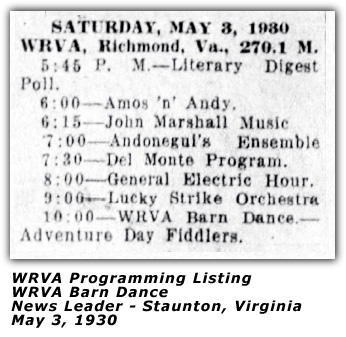 In February 1930, the station applied with the FCC to increase its power to 50,000 kilowatts. Approval of the application was expected in the following
spring. The cost of the new transmitter was estimated to be $500,000. Its location was planned to be about 20 or 30 miles outside of Richmond. Plans
were pending approval of the application. The station wanted to boost its daytime coverage. Station General Manager C. T. Lucy stated coverage
could extend as far as the middle western states.
In February 1930, the station applied with the FCC to increase its power to 50,000 kilowatts. Approval of the application was expected in the following
spring. The cost of the new transmitter was estimated to be $500,000. Its location was planned to be about 20 or 30 miles outside of Richmond. Plans
were pending approval of the application. The station wanted to boost its daytime coverage. Station General Manager C. T. Lucy stated coverage
could extend as far as the middle western states.
In the early 1930's, the newspapers in Danville, Staunton and Newport News, Virginia discontinued publishing the radio programming for WRVA and instead
focused on a couple of stations in New York (WEAF, WABC, WJZ).
The station struggled with getting reception to its audience, especially during the day as its signal would not reach long distances.
At night, the struggle was with other stations at or near the same frequency causing interference. In May of 1935, the station
ran ads touting its new transmitter. The signal was said to be increased and fading decreased. It was asking listeners
to let the station know if they heard an improvement.
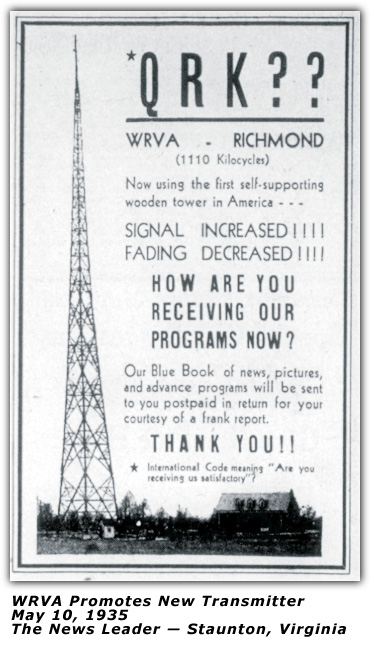
Even in its early days, WRVA had notions of having a 'barn dance'. A program listing from May of 1930
shows a program airing on a Saturday night at 10:00pm called "WRVA Barn Dance", featuring "Adventure Day Fiddlers".
Not much else can be found about this show, but one can imagine it was fiddle music similar to rural gatherings where dances were held.
In April 1930, Richmond held an event called "Adventure Days" which featured a fiddlers contest
on May 3, 1939 ("Play Day"), which was open to all fiddlers in Virginia. The winner
would get a trophy along with an invitation to be part of a broadcast over WRVA. The
event was to be held at 3:00pm at the Byrd Park House. A 1930 article spoke to fiddling in Virginia:
"The place of fiddling as an ancient and honored art in Virginia has given
it a place on the Adventure Days program, which depicts the history
of the Commonwealth. Fiddlers for generations have scraped pleasing tunes at barn
dances and halls, at weddings and around homely firesides in the wilderness to shut
out the loneliness and long miles between homes."
The year of 1931 saw the emergence of another local group that reached some
popularity due to its appearances over WRVA — The Churchville Brier-Jumpers.
This group broadcast a program of "string music". The group consisted of Jesse MacManaway,
Jesse Baylor, Wade Whitesell and G. W. Shull.
Another group that may have been another of the rural string bands that were
appearing now and again on WRVA — Grand Caverns String Band. The band
members included C. W. Morrison, violin; C. H. Morris, banjo; and Avia Eakle, guitar.
It appears that Mrs. C. H. Morris was a vocalist with the group.
In the 1930's, many stations were joining the networks that were growing at the time.
Some point out that it was of financial necessity due to the economy in the 1930's.
WRVA joined the CBS Network in November of 1936. The initial contract was
for five years and would have WRVA broadcasting 25 hours of network programming
a week.
During the 1930's, newspapers began to just carry the network program listings
instead of individual radio stations. This included those newspapers in Staunton,
Newport News and Danville that previously listed much of WRVA's programming.
On March 15, 1939 at 8:00pm, WRVA dedicated a new 50,000 watt radio transmitter with a seven hour broadcast
marked with special programming for the occasion. It was the only station in Virginia broadcasting with that kind
of power. The station was then a part of the Columbia and Mutual networks.

In researching some of the names or acts found in WRVA program listings one can find some interesting tidbits. In April 1939,
Burt Repine was doing a show called "WRVA Swing Club" at 10:00pm. He would later become music director for WRVA for a time,
then he was the personal manager for Janis Martin while she was at WRVA in 1956. Emcee for Burt's show was Ward Adams,
who would also later be emcee on the WRVA Old Dominion Barn Dance shows.
December 1939 - Old Dominion Barn Dance Begins
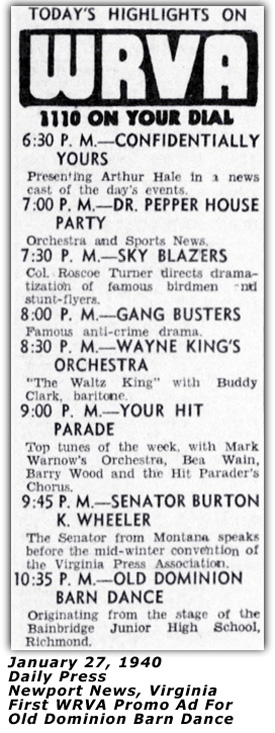 By the late 1930's, WRVA had become a CBS network affiliate and was broadcasting many network shows.
The station began to also broadcast more local, live shows. One of them was the WRVA Old Dominion
Barn Dance. Prior to the start of that program, the station had brought in a couple of new acts
to become part of their broadcast lineup.
By the late 1930's, WRVA had become a CBS network affiliate and was broadcasting many network shows.
The station began to also broadcast more local, live shows. One of them was the WRVA Old Dominion
Barn Dance. Prior to the start of that program, the station had brought in a couple of new acts
to become part of their broadcast lineup.
One was a group Hoyt "Slim" Bryant's was working with at the time, the Georgia Wildcats that was led by Clayton McMichen. Hoyt would
later move on to KDKA in Pittsburgh with his own group, the Wildcats. We are privileged to have access to correspondence between Hoyt Bryant
and Phil Collins (son of fiddler Curley Collins). In a letter to Phil dated October 7, 2002, he writes that when they started the Old Dominion
Barn Dance, the show had many guests that appeared. These included such acts as the Sons
of the Pioneers, Carson J. Robison, the Harmonica Rascals and Sunshine Sue. The show started
in a high school gym (see the accompanying ad from January 1940). But the show was proving
to be too popular. The show had to be moved to the Mosque Theater where the crowds were
2,000 to 3,000 every Saturday night. The show was then broadcast on the Mutual Network.
Hoyt told Phil that Ward Adams was the emcee of the show. He also noted that Pat Binford
was one of the original cast members of the barn dance.
 Slim had come to Richmond in the late 1930's with Clayton's group and indicating they were
playing on the Old Dominion Barn Dance (published radio logs in newspapers have only shown
the January 1940 show as the first one seen). Slim indicated that Clayton left the group
and went back to Kentucky - he preferred a more big band sound. Hoyt, though, liked the low
overhead of a small string band and stayed in Richmond. By this time Hoyt's brother, Raymond (Loppy)
Bryant was playing bass in the band. But sometime during 1940, there was a union work
stoppage. Hoyt traveled back to western Pennsylvania to visit with his wife's family. During
that visit, he had a meeting with the program director of KDKA, George Heid, who was also
an old friend of Hoyt's. Mr. Heid offered Hoyt a job. On August 10, 1940, Slim Bryant
and His Wildcats began a 20 year stint with KDKA radio and television.
Slim had come to Richmond in the late 1930's with Clayton's group and indicating they were
playing on the Old Dominion Barn Dance (published radio logs in newspapers have only shown
the January 1940 show as the first one seen). Slim indicated that Clayton left the group
and went back to Kentucky - he preferred a more big band sound. Hoyt, though, liked the low
overhead of a small string band and stayed in Richmond. By this time Hoyt's brother, Raymond (Loppy)
Bryant was playing bass in the band. But sometime during 1940, there was a union work
stoppage. Hoyt traveled back to western Pennsylvania to visit with his wife's family. During
that visit, he had a meeting with the program director of KDKA, George Heid, who was also
an old friend of Hoyt's. Mr. Heid offered Hoyt a job. On August 10, 1940, Slim Bryant
and His Wildcats began a 20 year stint with KDKA radio and television.

Also on the scene at WRVA during the same time was a group known as the Tobacco Tags.
In 1938, that group consisted of Luke "Looney Luke"(Beucom), Reid "Roly Poly Reid" (Summey), Bob (Hartsell?)
and Harvey "Hash House" (Ellington?). They also appeared on the Virginia Farm
and Home Hour show regularly.
There was also an act known as the Domino Hillbillies that had a show on Tuesday and Thursdays
from 2:00pm to 2:15pm. Presumably the group was named for one of the cigarette
brands of the tobacco company that owned the station.
From November 1939 through end of May 1940, there was a version of the Old Dominion Barn Dance
that aired over WRVA and was on the Mutual Broadcasting Network. The show was not always staged
in Richmond. The Daily Press in Newport News, Virginia published a detailed WRVA program listing
in that year and would include where the show was being held on Saturday nights.
The first program aired on November 11, 1939 and was held at the Bainbridge Junior High School
Auditorium in Richmond. WRVA must have foreseen the popularity of the show for they
scheduled two performances in one evening expecting a large turnout.
The Richmond Times-Dispatch did include an interesting tidbit about one of the acts, Jake
and the Boys. They were on the WRVA "reliable list" due to their Thursday night shows
with Pat Binford as their emcee. But the article notes that Pat had tried his best and well,
"...they make no particular point of finishing a tune together. They're individualists, each
a temperamental artist in his own right, so it really doesn't matter..." Pat was there to keep
them in line or was that wishful thinking?
That first show was indeed a hit. The station received numerous requests from the attendees
and from others who could not get in. The next show was immediately scheduled. A new article
notes that the cast "...put on one of the most entertaining performances ever enjoyed in this area."
It was reported that nearly 400 persons could not attend that first show due to seating capacity.
More seats were added for the second show.
What is interesting to note is that the "profits" from the show went to the South Side Athletic
Club, who endeavored to help the welfare of the youth.
The Richmond Times-Dispatch continued to gush over this new live broadcast. And provides even
more details about acts that were on the shows. A November 23, 1939 article mentions that
one act was the Goule Sisters were on the second show and had been booked for the third show.
It also mentions they were initially directed by Larry Drinard (Poky of Smoky and Poky) when
they first started doing radio work. In addition, it was reported that the Georgia Wildcats along
with Smoky and Poky were being sponsored by a local tobacco manufacturer to do electronic transcriptions
of programs that were to be distributed to 20 different cities.
The momentum continued for the show and a fourth show was booked. A December 2, 1939 article
mentions that the cast was the same as previous shows, "...an entirely new routine has
been arranged."
A look at the WRVA Dialog of April 1940 shows that the Carter Family had a one hour
show Monday through Saturday from 6:00am to 7:00am. The Georgia Wildcats were on
for 15 minutes from 7:00am to 7:15am. They would perform again between 3:00pm and 3:15pm
on Monday, Wednesday and Friday. The Tobacco Tags were on from 8:00am to 8:15am.
|
WRVA Old Dominion Barn Dance - Venues 1939 - 1940
|
|
| Date |
Venue |
City |
Stars Listed in Ads or Articles |
| 11/11/1939 |
Bainbridge Junior H. S. |
Richmond |
Georgia Wildcats; Tobacco Tags; Domino Hillbillies; Smoky and Poky; Jake and the Boys; Ward Adams; Pat Binford |
| 11/18/1939 |
Bainbridge Junior H. S. |
Richmond |
Georgia Wildcats; Tobacco Tags; Domino Hillbillies; Smoky and Poky; Jake and the Boys; Little George; Goule Sisters; Ward Adams; Pat Binford |
| 11/25/1939 |
Bainbridge Junior H. S. |
Richmond |
Georgia Wildcats; Tobacco Tags; Domino Hillbillies; Smoky and Poky; Jake and the Boys; Doris Andrews; Goule Sisters; Wonder Valley Boys; Ward Adams; Pat Binford |
| 12/2/1939 |
Bainbridge Junior H. S. |
Richmond |
Georgia Wildcats; Tobacco Tags; Domino Hillbillies; Smoky and Poky; Jake and the Boys; Doris Andrews; Goule Sisters; Wonder Valley Boys; Ward Adams; Pat Binford |
| 12/9/1939 |
South Norfolk H. S. |
South Norfolk |
Georgia Wildcats, Tobacco Tags, Smokey and Pokey, Ward Adams, Pat Binford |
| 1/6/1940 |
Bainbridge Junior H. S. |
Richmond |
Guest Stars: Southside Ramblers;
Cast: Georgia Wildcats; Tobacco Tags; Domino Hillbillies; Jake and the Boys; Johnny Hughes; Doris Andrews; Johnny Warren; Little George; Smoky and Poky; |
| 1/13/1940 |
Bainbridge Junior H. S. |
Richmond |
Georgia Wildcats; Tobacco Tags; Domino Hillbillies; Ward Adams' Gang; Little George; Smoky and Poky; Doris Andrews; Johnny Warren; Johnny Hughes; Little Mary Latimer; Pat Binford |
| 1/20/1940 |
Bainbridge Junior H. S. |
Richmond |
Georgia Wildcats; Domino Hillbillies; Tobacco tags; Ward Adams' Gang; Smoky and Poky; Little George; Doris Andrews; Johnny Hughes; Sunrise Hillbillies |
| 1/27/1940 |
Bainbridge Junior H. S. |
Richmond |
Georgia Wildcats; Tobacco tags; Domino Hillbillies; Jack and the Boys; Ward Adams' Gang; Little Mary Latimer; Smoky and Poky; Little George Haab; Doris Andrews; Johnny Warren; Johnny Hughes; Pat Binford |
| 2/3/1940 |
Bainbridge Junior H. S. |
Richmond |
Guests: Sunrise Hillbillies;
Cast: Georgia Wildcats; Tobacco Tags; Domino Hillbillies; Jake and the BOys; Ward Adams' Gang; Smoky and Poky; Doris Andrews; Johnny Warren; Johnny Hughes; Little George Haab; Pat Binford |
| 2/10/1940 |
Bainbridge Junior H. S. |
Richmond |
Guest: Sunshine Sue and Her Rangers (first appearance);
Cast: Georgia Wildcats; Tobacco Tags; Domino Hillbillies; Jake and the Boys; Smoky and Poky; LIttle Georgie; Doris Andrews; Johnny Hughes; Johnny Warren |
| 2/17/1940 |
Bainbridge Junior H. S. |
Richmond |
Tobacco Tags; Georgia Wildcats; Domino Hillbillies; Ward Adams; Sunshine Sue and Her Rangers; Smoky and Poky; LIttle GEorge; Doris Andrews; Johnny Warren; Johnny Hughes; Pat Binford |
| 2/24/1940 |
Bainbridge Junior H. S. |
Richmond |
Guest: Sunshine Sue and her Rangers;
Cast: Georgia Wildcats; Tobacco Tags; Domino Hillbillies; Jake and the Boys; Smoky and Poky; Doris Andrews; Little George; Johnny Warren; Johnny Hughes; Ward Adams; Pat Binford; |
| 3/2/1940 |
Bainbridge Junior H. S. |
Richmond |
|
| 3/9/1940 |
Bainbridge Junior H. S. |
Richmond |
|
| 3/16/1940 |
Mosque Auditorium |
Richmond |
Guests: Sons of the Pioneers;
Cast: Georgia Wildcats; Tobacco Tags; Sunshine Sue and Her Rangers; Smoky and Poky; Doris Andrews; Little George Haab; Johnny Hughes |
| 3/23/1940 |
Mosque Auditorium |
Richmond |
Guest stars: Sunrise Hillbillies with Bill Stell from WRNL; Rural Rhythm Boys of Harrisonburg;
Fiddling Contest: Emory Stroop versus Kenny Newton of Ga. Wildcats;
Cast: Georgia Wildcats; Tobacco Tags; Sunshine Sue and Her Rangers; Smoky and Poky; Doris Andrews; Johnny Warren; Bob Dyson; Little George Haab; Pat Binford; Ward Adams |
| 3/30/1940 |
Mosque Auditorium |
Richmond |
Guest Stars: Sunrise Hill Billies with Bill Stell of WRNL; Jerry Montana and Her Boys; Jake Tyler's Gang;
Band Contest: Jerry Montana's Band versus Sunrise Hillbillies;
Cast: Georgia Wildcats; Tobacco Tags; Sunshine Sue and Her Rangers; Smoky and Poky; Doris Andrews; LIttle George; Bob Dyson; Ward Adams; Pat Binford |
| 4/6/1940 |
Mosque Auditorium |
Richmond |
Guest star: Carson J. Robison;
Cast: Georgia Wildcats; Tobacco Tags; Sunshine Sue and Her Rangers; Smoky and Poky; Little George; Doris Andrews; Everett Baughman; Bob Dyson; Johnny Warren |
| 4/13/1940 |
Mosque Auditorium |
Richmond |
Big Laff Show; Swingbilly Wedding |
| 4/20/1940 |
Mosque Auditorium |
Richmond |
|
| 4/27/1940 |
Mosque Auditorium |
Richmond |
Sunshine Sue and her Rangers; Tobacco Tags; Georgia Wildcats; Ward Adams' Gang; Pat Binford; Smoky and Poky; Little George Haab; Bob Dyson; Doris Andrews; Everett Baughman; Dancing Famerettes; Fred Jackson; Comedy: Mock Court Scene: Newlyweds Delphinia and Luke air trials and tribulations to Judge Slim Bryant; Smoky gets "chicken disappearing charge". |
| 5/4/1940 |
Petersburg Highschool |
Petersburg |
Sunshine Sue and her Rangers; Tobacco Tags; Georgia Wildcats Bob Dyson; Doris Andrews; Pat Binford |
| 5/11/1940 |
Newport News H. S. |
Newport News |
Sunshine Sue and her Rangers; Tobacco Tags; Georgia Wildcats; Ward Adams; Pat Binford |
| 5/18/1940 |
Petersburg Highschool |
Petersburg |
Sunshine Sue and her Rangers; Tobacco Tags; Georgia Wildcats; Bob Dyson; Doris Andrews; Pat Binford |
| 5/25/1940 |
Mosque Auditorium |
Richmond |
Guest stars: Rouse Brothers;
Cast: Sunshine Sue and Her Rangers; Georgia Wildcats; Tobacco Tags; |
| 6/1/1940 |
Mosque Auditorium |
Richmond |
Guest star: Harmonica Rascals;
Cast: Georgia Wildcats; Tobacco Tags; Sunshine Sue and Her Rangers; Smoky and Poky; Ward Adams; Pat Binford; Joe Brown's Junior Hillbillies; Broad Rock Hillbillies; Jerry Richardson (3yr old tap dancer); Otie Bridgman (14 yr old yodeling cowboy); |
| 6/8/1940 |
Mosque Auditorium |
Richmond |
Guest stars: The Musical Aces of Tidewater, Virginia
Cast: Georgia Wildcats; Tobacco Tags; Sunshine Sue and Her Rangers; Bob Dyson; Doris Andrews; Little George; Ward Adams; Pat Binford;
Feature Night: (1)Battle of the Sexes: Bass Fiddle Contest: Pearl McMullen of Aces versus Loppy Bryant of Wildcats; (2)"The Great Western Love Scene" with Roly Poly Reid (as Prairie Nell), Looney Luke (as great cowboy lover) and Slim Bryant (as domesticated husband) |
| 6/15/1940 |
Mosque Auditorium —Final Show |
Richmond |
Guest stars: Kid Smith and the Smith Sisters of WFVA; Joe Brown's Junior Hillbillies; Rio Valley Rangers of WMBG;
Cast: Georgia Wildcats; Tobacco Tags; Sunshine Sue and Her Rangers; Smoky and Poky; Ward Adams; Pat Binford; |
1940 - Sunshine Sue Arrives At WRVA - First Time
 Sunshine Sue made her first appearance on the Old Dominion Barn Dance on February 10, 1940.
An article in the "Southside Supplement" of the Richmond Times-Dispatch noted that
her group "...met with such warm response that they have been engaged for this week's show (sic, February 17, 1940)."
The article further noted that though they had only been on WRVA for a short time, they had
already gained "considerable popularity" and were seen to have promise as one of the highlights
of the show's cast.
Sunshine Sue made her first appearance on the Old Dominion Barn Dance on February 10, 1940.
An article in the "Southside Supplement" of the Richmond Times-Dispatch noted that
her group "...met with such warm response that they have been engaged for this week's show (sic, February 17, 1940)."
The article further noted that though they had only been on WRVA for a short time, they had
already gained "considerable popularity" and were seen to have promise as one of the highlights
of the show's cast.
|
WRVA Old Dominion Barn Dance - 1940
|
|
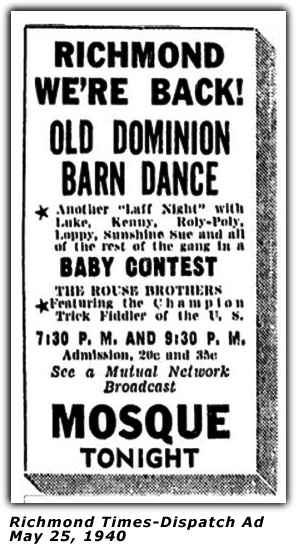 |
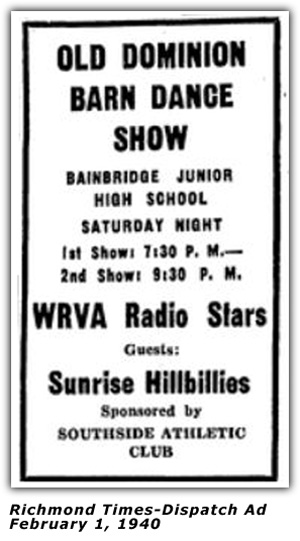 |
In his presentation at the International Country Music Conference in May of 2015, author Dr. Wayne W. Daniel
touched upon the beginning of Sunshine Sue's musical journey. He pointed to an article in the old WLS Stand-By
publication dated October 17, 1936. Prior to WLS, she was part of a family group that was performing over
KRNT in Des Moines, Iowa as the Rock Creek Ramblers and Sunshine Sally. While in Chicago one Saturday night,
Harold Safford auditioned them between shows of the barn dance. Harold liked what he heard and wanted George Biggar
to hear them, so the group went back on stage after the barn dance was over. But since WLS already had a group
named the Prairie Ramblers, the group's name was changed to Rock Creek Rangers to avoid confusion. WLS also had
to performers named "Sally", so Sunshine Sally became Sunshine Sue, a name which she was known as for the rest
of her musical career. The group consisted of the three Workman brothers, Sam, George and John (who was married to "Sue").

The February 15, 1940 article includes a hint of the growing popularity of the show. Management
had to arrange for additional seating at the Bainbridge School and in the event of bad weather,
also arranged for ample space indoors for those waiting to get in for the second show. The February 17, 1940
show was sponsored by the South Side Athletic Club, which was "...active in welfare activity
in South Richmond." The club was putting together a boxing team for an upcoming Golden Gloves tournament.
Sunshine Sue was first mentioned in the March 1940 WRVA Dialog. Her first over the air
appearance was a 15 minute program on Monday, February 5, 1940.
As you will see, she would later become the Old Dominion
Barn Dance 'femcee'. In April had a 15 minute show from 12:15pm to 12:30pm that aired on Monday,
Tuesday, Wednesday and Friday. On Thursday, her show was on at 9:15am. The publication
mentioned that Sunshine Sue and Her Rangers came to Richmond from radio station WHAS
in Louisville, Kentucky.
While that 1939-1940 edition of the Old Dominion Barn Dance ended it does not mean that WRVA gave up
on the idea of a 'live' entertainment program of that type.
Research shows that the Old Dominion Barn Dance name was used to advertise personal appearances
in the Richmond area that featured acts that were part of that show. In February 1941, ads show
the Old Dominion Barn Dance being held on Thursday and Friday nights at the Riviera
Tavern. The ads promoted a "complete floor show". The Tobacco Tags and
Blackie (Blacky) Skiles and His Lazy K Ranch Boys seemed to be the headliners
and driving forces behind those shows.
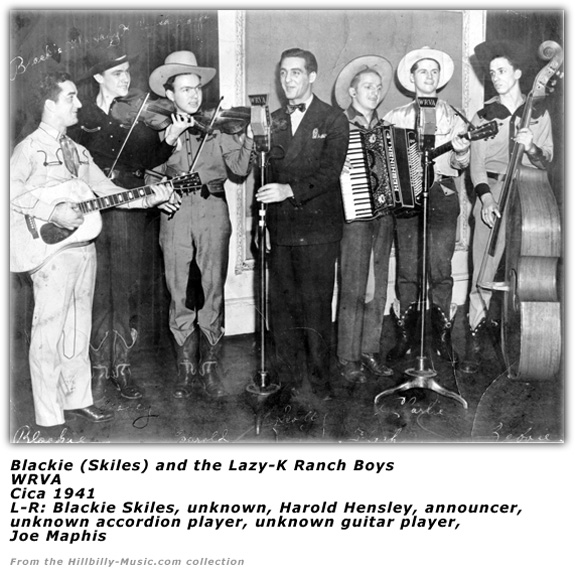
In one picture seen of Blackie's group, the band included
Harold Hensley on fiddle (Harold later joined Cliffie Stone's Hollywood Barn Dance show) and Joe Maphis on bass. The show in February included Smoky and Poky,
Johnny Whitaker, the Shapiro Twins (skate dancers) and Gwynn Lewis who was billed
as the "Mistress of Songs" for appearances on February 20 and 21, 1941. A week later, the Riviera
Tavern was promoting dances on Wednesday, Friday and Saturday nights. The Barn Dance show
was held on Thursday night but the Richmond Times-Dispatch radio log for the day does not show
WRVA (or WRNL or WMBG) broadcasting the show.
The familiar faces of the barn dance continued to put on shows in Richmond. Another example
was a "Dixie Jamboree" that was held at the Mosque on Saturday March 1 and offering
two shows - 7:30pm and 9:30pm. Sunshine Sue was the headliner. Also appearing were the Lazy K
Ranch Boys, the Tobacco Tags (who were returning to Richmond as well as Roger Hickey and
Sally Flowers.
Research shows a "Virginia Barn Dance Jubilee" being staged on the Petersburg Fair Grounds
in Petersburg, Virginia in June of 1941. That show featured the Tobacco Tags and Sally Flowers with
Joe Brown as Master of Ceremonies. It was also following the barn dance practice of two shows
on Saturday nights. A June ad said the show was every Saturday night, but no other ads for the
show were seen after June.
The only "barn dance" show being broadcast in Richmond in the summer of 1941 was the network
show for the WLS National Barn Dance.
Starting on Saturday night November 22, 1941, the WRVA program listings in the Richmond Times-Dispatch were showing
the Virginia Barn Dance on Saturday nights. A Newport News newspaper indicated that Sunshine Sue
was a part of the show. But the show was not running any ads in the local paper. It also appears
that this version of the show may have been held in a venue other than the Mosque or Lyric (later, WRVA Theatre).
In January 1942, an ad suggests the show was only doing one performance each night. Sunshine Sue
seemed to be the headline act. "Crazy Joe" would be Joe Maphis.
An April 11, 1942 ad provides an indication of who was a part of the show, which was at the Mosque.
It promoted as a two hour stage show and part of it was to be broadcast.
August 1942 - Sunshine Sue Leaves WRVA
However, it appears that run of the barn dance show was not successful as no further broadcasts were
seen in the remainder of 1942. In fact the end of the summer saw more changes to WRVA.
Saturday, August 29, 1942, appears to have been Sunshine Sue's last show during this particular
stint with WRVA. She was moving to Cincinnati to become part of the WLW staff.
Sunshine Sue and Her Rangers initially had a 15 minute broadcast over WLW. The station had
quite a few well known acts on their program schedule. A look at the Saturday morning
programs for September 12, 1942 shows Curly (Fox), (Texas) Ruby and Jim Day; the Golden West Girls;
and The Drifting Pioneers (which included Merle Travis). On Saturday evening, the Boone County Jamboree was aired.
When Sue left WRVA for WLW, one might want to know who was in her group the "Rangers". Research
shows that she made her first appearance on the WLW "Boone County Jamboree" on the evening of
August 29, 1942. The Cincinnati Enquirer actually had a photo accompanying this announcement.
In the picture was: Ramona Riggins (she was cast as an Indian at WRVA). Ramona would later meet
Grandpa Jones and get married in October of 1946. John Workman, Sue's husband was in the group.
Sam Workman - John's brother as well. Other members were Joe Maphis and another female singer by
the name of Jane Allen. The three female performers in the group were billed as the Happy Valley Girls. Sue and her group would
then be on the air Monday through Friday between 5:00am and 6:00am.
One starts to think that she is gathering some business insight into what it takes to run a successful
live jamboree or barn dance show with her tenure at WLW and previously at WLS earlier in her career.
Other acts on the Boone County Jamboree when she first joined included Bradley Kincaid, Grandpa Jones,
Merle Travis, Curly Fox and Texas Ruby, Happy Hal O'Halloran, Dolly Good, Prairie Sweethearts,
Hugh Cross, Pa and Ma McCormick, Roy Starkey, Delmore Brothers, Buddy Ross, Boone County Buccaneers (who were also
known as Captain Stubby and the Buccaneers), Grand pappy Doolittle as well as Sunshine Sue and Her Rangers and her female
trio, Happy Valley Girls.
In the months subsequent to her departure, it appears WRVA was undergoing programming changes.
Little hillbilly music programming seemed to be on the air in the radio logs seen. Joe Brown's Radio
Gang seems to be something that survived. Perhaps the war time effort was also impacting
the availability of performers. An ad for Miller & Rhoads asked for readers to turn in their
"Junk Jewelry" as it could help the soldiers serving in the Asian and African war zones.
September 18, 1944 - Sunshine Sue Returns to WRVA
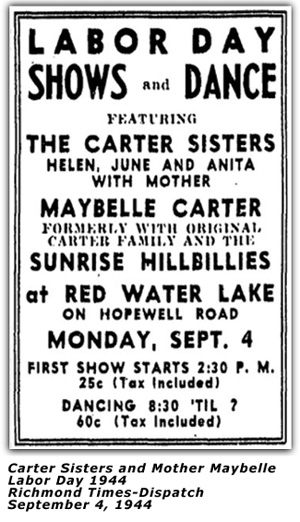 Perhaps a preview of the return of familiar entertainment to the Richmond area was seen
when the Carter Sisters (Helen, Anita and June) and Mother Maybelle were promoting a Labor Day
appearance at Red Water Lake. Then a couple weeks later, another familiar face and voice returns.
Perhaps a preview of the return of familiar entertainment to the Richmond area was seen
when the Carter Sisters (Helen, Anita and June) and Mother Maybelle were promoting a Labor Day
appearance at Red Water Lake. Then a couple weeks later, another familiar face and voice returns.
On September 17, 1944, the Richmond Times-Dispatch had an ad from WRVA touting the return
of Sunshine Sue to WRVA with a daily show at 3:30pm, Monday through Friday. But it did not seem
to herald any new live "barn dance" type shows yet.
Perhaps it was just the beginning and planting
the seeds for what was to come. She had by that time experience with successful shows at WLS in
Chicago, WLW in Cincinnati and WHAS in Louisville.
The WRVA program listings through the end of 1944 do not show any other acts that one might
term hillbilly or country music.
Towards the end of 1944, Rufe Davis brought a "Barn Dance Revue" to the Mosque. It received
an article in the local paper telling readers of who would be a part of the revue.
One also finds the marketing efforts of Sunshine Sue as ads appear promoting her personal appearances.
November 1944 saw John Lair bring his Renfro Valley Barn Dance show to Richmond as part
of cities participation in buying war bonds. The show was held on November 21, 1944 at
the Mosque. Tickets were based upon the amount of the bond purchased at local theaters.
If a $100 bond was bought, that would get a person a seat in the front part of the orchestra
or a loge seat. If one bought a $50 bond, a seat in the rear of the orchestra or in the front
part of the mezzanine was to be had. Finally, a $25 bond got one a seat in the rear of the mezzanine
or in the balcony.
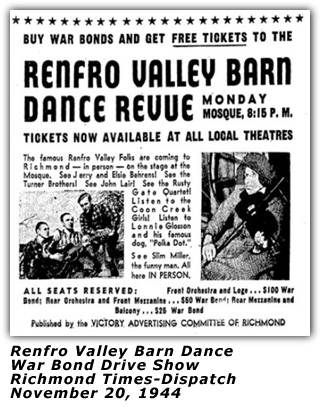 The article promoting the show also stated that it was customary for all War Bond shows
in the city to reserve a portion of the Mosque for Negro bond buyers, who purchased their
bond and tickets at the Negro theaters.
The article promoting the show also stated that it was customary for all War Bond shows
in the city to reserve a portion of the Mosque for Negro bond buyers, who purchased their
bond and tickets at the Negro theaters.
Appearing on this show would be the Coon Creek Girls, Lilly May, the Turner Brothers,
Slim Miller, Jerry and Elsie Behrens and others.
The article states the overall quota for Richmond for the "Sixth War Loan Campaign" that was
to run from November 20 through December 16 was $39,850,000. The quota for E Bonds
was $5,550,000 and only people that bought the E Bonds were eligible for tickets to the
Renfro Valley show.
The day after the show, the Richmond Times-Dispatch headlined an article, "2,246,900 In Bonds Sold
At Mosque". Individuals who bought the E Bonds purchased $246,900 worth; $2,000,000
was purchased by the Life Insurance Company of Virginia. They turned over their box seats to
wounded veterans near-by camps and hospitals.
The theater was reported near capacity for the show and fans kept the Renfro Valley group on stage
until the show had to be brought to an "abrupt end" to catch their train back to Kentucky. The
article noted that the favorites of the audience seemed to be Slim Miller, 83-year old
Granny Harper, Lonnie Glosson with his 'talking harmonica', Jerry Behrens who did a version
of "Look Down That Lonesome Road" as well as six foot four Little Eller.
 During 1944, one of the early familiar voices had moved elsewhere. "Crazy" Joe Maphis
had moved to Chicago and was part of the WLS National Barn Dance. He was part
of a group called the "Corn Crackers" that included Lee Lunsford, Eli Haney and Curley Covard. Joe
was shown playing the fiddle for that group.
During 1944, one of the early familiar voices had moved elsewhere. "Crazy" Joe Maphis
had moved to Chicago and was part of the WLS National Barn Dance. He was part
of a group called the "Corn Crackers" that included Lee Lunsford, Eli Haney and Curley Covard. Joe
was shown playing the fiddle for that group.
But World War II was having its impact on country music entertainers as many well known
names were serving their country. In 1945, Cowboy Music World listed many of the artists
were in various branches of the service. Its November 1945 issue indicated that names
such as Gene Autry, Bob and Randy Atcher, Georgie Goebel, Floyd Tillman, Blaine Smith,
Ken MacKenzie, Ray Little, Rusty Gill, Joe Maphis, Buddy Durham, Big Jim DeNoone, Cy Williams (Milo Smick),
Jimmie Pierson Chuck Harding and others were in the United States Army. In the United States
Navy were Kenny Roberts, Olivio Santoro, Bud Bailey, The York Brothers, Joe Barker, Eddie Peabody,
George Long and others. The United States Marines counted Doye O'Dell, Bill Nettles, Jack Shook
and Texas Jim Robertson as part of their ranks. The Coast Guard included Sleepy Jeffers and others.
Early 1945 seems to show that country entertainment over the radio was coming back
in Richmond. March program listings show that the Carter Sisters and Sunshine Sue each had their own programs on
radio stations WRNL and WRVA respectively. Jim Hall and His Radio Mountaineers had
a program on radio station WMBG and were promoting their performances in the area as well, using
the term 'radio barn dance' perhaps to evoke an image of past shows seen in the area.
In the summer of 1945, the Tobacco Tags were playing over radio station WPTF in Raleigh, North Carolina.
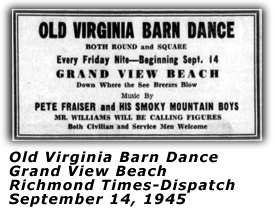 In the fall of 1945, another attempt was made to revive a barn dance type of show.
This one was called "Old Virginia Barn Dance" and was advertised as being every Friday
night beginning September 14, 1945. It was to be held at Grand View Beach. Pete Fraiser
and his Smoky Mountain Boys was the band offering up the music. Round and Square Dances
were to be featured.
In the fall of 1945, another attempt was made to revive a barn dance type of show.
This one was called "Old Virginia Barn Dance" and was advertised as being every Friday
night beginning September 14, 1945. It was to be held at Grand View Beach. Pete Fraiser
and his Smoky Mountain Boys was the band offering up the music. Round and Square Dances
were to be featured.
The nation was still raising funds with War Bond drives and Sunshine Sue and her Rangers
were featured in some of those efforts.
In October of 1945, the Manchester Lions Club held their Ninth Annual "Roaring Revuew" over
three nights at the Bainbridge Junior High School. Proceeds from these shows were to go to
the city's underprivileged children for food and medical care. The Thursday night
show included Jim Hall and His Radio Mountaineers.
The Friday night show was emceed by Harvey "Juke Box" Hudson of WRVA. Acts that performed that night
were Burt Repine (who later became personal manager for Janis Martin) and his orchestra featuring
Kitty Breeze as vocalist, the Sunrise Hillbillies and the Rangers' Quartet among others.
Saturday night's show had Joe Brown and Harvey Hudson of WRVA sharing emcee chores. On the program
that night were Sunshine Sue and Her Rangers, the Carter Sisters with Mother Maybelle Carter,
Snowball Crump, a well-known Negro dancer as well as other acts. The veteran hillbilly performers
associated with WRVA appeared on more than one occasion with Snowball Crump which raised some
eye-brows of the local audiences and promoters. But Phil Collins, son of Curley Collins
indicated that his father told him that if they had to exclude Snowball, there would be no show.
The "hillbilly" performers were remembered for their support at Snowball's funeral.

 In March of 1946, WRVA began airing a program called the WRVA Barn Dance that
ran Monday through Friday at 3:15pm. It would star Sunshine Sue and Her Rangers. Also on the show
would be the Tennessee Ramblers with Jack Gillette. A 'new singer' named Jimmy Gould would
also be a part of the half-hour show. Jack's group had a program called "Dixie Hayride" that aired
at 4:30pm for a half-hour. Not much else was said about this show and presumably Jack Gillette's group
did not stay long at the station.
In March of 1946, WRVA began airing a program called the WRVA Barn Dance that
ran Monday through Friday at 3:15pm. It would star Sunshine Sue and Her Rangers. Also on the show
would be the Tennessee Ramblers with Jack Gillette. A 'new singer' named Jimmy Gould would
also be a part of the half-hour show. Jack's group had a program called "Dixie Hayride" that aired
at 4:30pm for a half-hour. Not much else was said about this show and presumably Jack Gillette's group
did not stay long at the station.
But changes started happening at WRVA. On June 15, 1946, the Richmond Times-Dispatch reported
that "WRVA Signs Lease for Lyric". General Manager C. T. Lucy, general manager at WRVA indicated
that it was a long term lease ("number of years"). The article outlined the "policy" of how
WRVA would manage the old Lyric Theater, located at Ninth and Broad Streets in downtown Richmond.
The first change was renaming it to WRVA Theater. The approach would be an "aggressive live show"
policy. They wanted to maximize the number of bookings at the theater. WRVA had already begun
contacting various booking agencies including concert and musical booking bureaus.
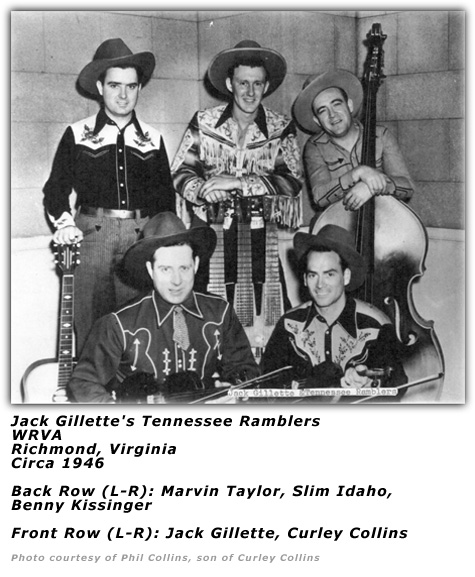 Management also stressed that while there would be some changes to modernize the theater
and make it more comfortable, an effort to "...made to preserve the nostalgic charm
the old house has for Richmond theater-lovers and old-timers of the stage." Mr. Lucy
envisioned that they would merge the "oldest of the entertainment arts, the stage, ... join
hands with the newest, radio."
Management also stressed that while there would be some changes to modernize the theater
and make it more comfortable, an effort to "...made to preserve the nostalgic charm
the old house has for Richmond theater-lovers and old-timers of the stage." Mr. Lucy
envisioned that they would merge the "oldest of the entertainment arts, the stage, ... join
hands with the newest, radio."
WRVA was to take over the theater operations in the fall of 1946 and had started with
proceeding to renovate the theater and get its new name up in neon to 'brighten' the corner
of Ninth and Broad.
Times-Dispatch columnist Edith Lindeman discussed the plans that Jack Stone and Barron Howard
of WRVA had for the theater. Neither gentleman had ever run a theater but were aware
of the local audiences who wanted a variety of theater presentations. The two indicated
they needed to make the theater "presentable and comfortable", so large expenditures would be
made for refurbishing and decorating. Alluding to the need to make performers comfortable,
a good deal of effort would be made behind or below the stage area that performers used
for changing. In the past, that could have meant freezing or sweltering or rushing to get their costumes
away from water from sudden rains and repairing the stairs that led to the stage.
The gentlemen indicated that "We'd like to have the house alive every night of the week. Perhaps
we can't arrive at that goal during the first year of operation but we keep mulling over
possibilities." They wanted to revive the theater experience in Richmond where it would have
a reputation as a "good" theater town.
Mr. Stone was quoted as stating, "In the days of the old Academy, only a few Richmonders
felt it necessary to go away for their annual dose of drama and comedy. We'd like to bring those
days back. We have the theater and we have the enthusiasm. We'll get the plays or die trying."
Perhaps Ms. Lindeman was not quite convinced. She told readers at the end of this article, "For
future developments, watch this—and the obituary— column.
Sep 14, 1946—Sunshine Sue Leads New Era of WRVA Old Dominion Barn Dance
The transformation of the old Lyric Theater to the WRVA Theater was complete. Opening night
was to feature two performances—7:30pm and 9:30pm. Ticket pricing was simple, 60 cents for adults
and 30 cents for children. The Richmond Times-Dispatch ran an ad for the show on September 12, 1946
that would be the beginning of an ad appearing each week for the show through the departure of Sunshine Sue
in June 1957.
The following day, the local newspaper provided a review of that first show.
Governor Tuck and "...approximately 2,500 other devotees of hill-billy music" enjoyed the two shows.
The unnamed reporter, (only the initials E.L. were given at the end of the article, perhaps
that was Edith Lindeman who was unsure of the happenings when she did her interview just a
few weeks earlier) indicated that the show generated a warm reception which was a good
omen for the show that was to be done each Saturday night going forward.
"Youngsters who ganged up on the first rows squealed with delight,
whistles, applause and yowls of approval echoed from the galleries, babies gurgled and
grandma and grandpa tapped their feet and grinned behind their bifocals as old favorite
folk tunes and mournful new cowboy ballads rolled off the tongues and out of the instruments
of the tireless cast. For the hill-billy fans, it was their night to howl, and howl
they did in no uncertain terms."
A fifteen minute portion of the first show was broadcast over the air to give listeners
a sample of what was to come in the future. The WRVA radio programming list
in the local paper that day show a fifteen minute portion from 9:15 to 9:30pm. A full
hour broadcast was done from 10:00pm to 11:00pm. Governor Tuck was introduced to the audience
by Sunshine Sue on-stage in the second show. The Governor who enjoyed hillbilly music,
made a request to Sunshine Sue. She and her band complied and did "Red River Valley".
The reporter introduces the performers she saw in her own editorial fashion. There was
Pappy Ridgeway "who, in less bewhiskered moments, is WRVA's Scott Jarrett." Then she notes
Cousin Joe Maphis "..was imported from WLS's National Barn Dance" and made a guest appearance.
Perhaps she did not know of Joe's previous stints at WRVA prior to his move to WLS. The audience
would see and hear a familiar voice. She noted Joe "...was received as if he were the Sinatra
of the sagebrush."
Then there was Chester Atkins; he "...plucked a wicked electric guitar." She noted that
Curley Bradshaw, known as King of the Harmonica, "...blew out a reasonable facsimile of
a fox chase complete with barking dogs and snarling foxes." She goes on to note that Loony Luke
and his Tobacco Tags were back in Richmond by popular request. Cousin Elmer "...supplied much
of the hayseed humor." The show featured the debut of Claire and Arlene, two young singers
from the Richmond area. The team of Lilly and Curly "...teamed up for backwoodsy love songs
and lonesome ballads." Curly's real name was Sloan Kimbler; Lily's name was Lily Pickens.
"Corn and ham blended with "gittars", bull fiddling and yodels to make
the evening a happy occasion for the followers of the Old Dominion Barn Dance."
The opening proved to be a success and show began its run of Saturday night shows. In the early
ads in this iteration of the show, Sunshine Sue was the main star and WRVA was promoting as "the thing
to do Saturday night". The WRVA Theater began to see new bookings besides the Barn Dance as
the managers wanted to do with other productions. On October 18, 1946, the Musicians Club of Richmond
was to feature a recital by Maryla Jonas (a pianist from Warsaw, Poland) who had received
instruction from Paderewski. However only club members could attend and there were no guest cards
nor were tickets sold.
In December of 1946, The Barter Theatre gave a presentation
of Noel Coward's "Blithe Spirit" play. What is interesting to note is the contrast in
ticket prices. The barn dance was charging 90 cents for reserved seats, 60 cents for adults and
30 cents for children. The ticket prices for the play for the evening performance
were $2.40 for Boxes and Orchestra, $2.40 and $1.80 for Balcony and $1.20 for the Gallery.
 |
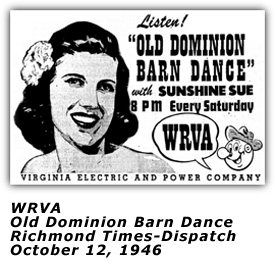 |
Sidebar: Chester / Chet Atkins
While doing research, one becomes aware of things or aspects that have been discussed about this show
or are in question. One aspect is the time that Chester / Chet Atkins was with the WRVA Old Dominion Barn Dance.
History shows he was part of that first show in September 1946. But history does not give a definitive answer
as to when he left. His biography indicated he was fired by Sunshine Sue. But when that Chet's biography
was released, the local Richmond newspaper interviewed Sunshine Sue to get her take on Chet's tenure and
departure from the Barn Dance. Her interview was discussed in the May 26, 1974 issue of the Richmond
Times-Dispatch by Norman Rowe. Chet's book mentions his departure in this review / interview
by Mr. Rowe. He had just gotten married, was out of work and wanted to be on a national radio
show. But he was homesick for Nashville. He also noted that the WRVA gig 'did not excite him'.
But Sunshine Sue offered her perspective of Chet's tenure at WRVA. She said she thought then
and still did that he was "...one of, if not the best guitar players in the country." Her thoughts
were that he was with the show about six months.
Sue then went into some detail about how personnel decisions were made. Sue and her husband, John
Workman, were hired by WRVA to 'secure talent'. They reported to Sam Carey, then program manager
and Barron Howard, general manager and Jack Stone, publicity manager. "All decisions were either
made or approved by them."
Sue indicates the decision was not hers alone and "...certainly not for lack of ability." One gets
the impression that perhaps Chester's / Chet's stage persona was a part of the decision as he himself
noted he was a bit shy. But one cannot argue what the body of Mr. Atkins' career eventually morphed into and
eventually a part of the Country Music Hall of Fame.
But further research indicates it may have been much less than six months. Juanita Milligan wrote
in her column "South of the Mason-Dixon Line" in the December 1946 issue of "Mountain Broadcast and
Prairie Recorder" that Chester was playing guitar for Red Foley on WSM back in Nashville.
Back to Our Story
The beginning of this new version of the barn dance did not mean that competition would not be
on the scene. In fact, on September 29, 1946, the "Ole Virginny Jamboree" was going to
be held at the Mosque Ballroom, offering four hours of entertainment and square dancing.
A local radio act, The Sunrise Hillbillies were providing the music, with Fred Lauterbach
calling the dances. Between sets, Dickie Radford's Orchestra would be providing entertainment.
This show also included broadcasting a 15 minute portion over WRNL.
As a geographical point of reference, the WRVA Theater was located at 9th and Broad Streets
in Richmond. The Mosque was at the corner of Laurel and Main Streets in Richmond, just over
one and a quarter miles from the WRVA Theater. The Bainbridge Junior High School that was
often used as venue in earlier years was located at the corner or near Bainbridge and Cowardin
Streets in South Richmond. The school was closed in 1975.
In early 1947, WRVA added a Saturday afternoon matinee show for the Old Dominion Barn Dance that
started at 2:30pm.
WRVA also developed a network of Virginia radio stations to widen the listening audience for the show.
The Virginia Electric and Power Company sponsored an ad in January 1947 listing the stations.
WRVA Old Dominion Barn Dance
Radio Network
|
|
| Station |
City |
State |
AM Frequency |
| WRVA |
Richmond |
Virginia |
1140AM |
| WGH |
Newport News |
Virginia |
1340AM |
| WFVA |
Fredicksburg |
Virginia |
1230AM |
| WCHV |
Charlottesville |
Virginia |
1240AM |
| WKEY |
Covington |
Virginia |
1340AM |
| WLPM |
Suffolk |
Virginia |
1450AM |
| WTON |
Staunton |
Virginia |
1400AM |
| WCNC |
Elizabeth City |
North Carolina |
1400AM |
| WCBT |
Roanoke Rapids |
North Carolina |
1230AM |
|
WRVA Old Dominion Barn Dance - 1947
|
|

As the show continued to grow in popularity, research starts to see milestones. The station
was keen to promote the popularity of this show and would brag about attendance when it
reached certain totals. One such show was on August 2, 1947 when they were to celebrate
the 100,000th attendee. To ensure it was a real celebration, WRVA advertised that the
show would include a "Hillbilly From Mars! He arrives on a Flying Saucer!". One could
only wish a picture existed of such events and antics.
Virginia's Governor William Tuck was a big fan of the show and the music. On Saturday night,
August 9, 1947, he was going to be on both shows and crown or coronate Sunshine Sue
as the "Queen of the Hillbillies". As a special giveaway that night, fans were to get a
recording of Sunshine Sue and Her Rangers doing an arrangement of "Red River Valley" (the
Governor's personal favorite) and on the other side, "Barn Dance Boogie". An article
touting the coronation mentions some of the musical numbers fans were to hear. The Tobacco Tags
were going to sing "Honey, Do You Think It's Wrong". June Carter was going to do a "comedy version"
of the song "Temptation". Crazy Joe Maphis was going to do his composition, "Barn Dance Boogie."
(Note: This is possibly the record on the Astra Record label—number 1215)
|
WRVA Old Dominion Barn Dance - 1948
|
|
The year of 1948 saw many 'themes' in the promotional ads as you will see. The focus seemed to be on comedy a bit
and each holiday brought a new opportunity to try something.
In May of 1948, Billboard gave it a 'second place award' and a mini-review. While just a short blurb,
it does indicate who was the producer of the show (Scott Jarrett) and who the annoucer was (Alden Aroe).
The reviewer says that WRVA show was one of the better-known and adept stations for giving the listening
audience live barn dance shows. The author wrote that Sunshine Sue femceed the show and "(did) better than just all right."
Tragedy struck the show on October 17, 1948. Slim Idaho, who was known for his triple-necked
steel guitar, was killed in a motorcyle accident along with his friend Charles Wiltshire. Their
motorcycle struck a car. Slim, whose real name was Dewey Hubbard Aderhold, died instantly. Mr. Wiltshire
died in a hospital of multiple injuries that night.
On November 22, 1948, the entire cast of the Old Dominion Barn Dance was to hold a benefit
show for Slim's wife at the WRVA Theatre. Other musicians such as the Tobacco Tags who were on WLEE and other local musicians
would perform as well. Dallas Ketcham, who was being mentored by Slim was to feature several
of Slim's original tunes and arrangements for the steel guitar. The services of the everyone
associated with the show that night including users, stage hands and musicians were being donated
and all proceeds were to go to Slim's wife.
A May 1948 Q&A column told readers he was 23 years old and was married, but no children. It indicated
that he had worked in Hollywood, appeared on the Grand Ole Opry as well as the WSB Barn Dance in Atlanta, Georgia.
But Slim had made an impact on the cast. Phil Collins relates a tidbit of the tribute the cast made
to Slim each year after his death. Benny Kissinger wrote a song called "Slim's Guitar". This song
was sung each year on the Old Dominion Barn Dance and later in the 1980's at Virginia's Lil' Ole Opry.
The theater would be darkened. A spotlight would shine on the actual guitar Slim played (loaned
by Slim's widow Mary). Benny would then sing "Slim's Guitar" in the darkness. Phil said it was
an incredibly emotional experience.
It Was Hillbilly Music and People
One of the aspects that stand out in this review and research of the WRVA Old Dominion Barn Dance
was its 'affectionate' use of the term "hillbilly" in various ways to sell the program. Catherine C. Morris
wrote a dissertation that touched upon this aspect a bit in her chapter she titled "It Was A Hillbilly Operation".
While she did write that WRVA shied away from network programming to adopt hillbilly and other types
of rhythm music versus rock and roll, this author would politely point out that rock and roll did not
happen until the mid to late 1950's.
She attempted to identify this "hillbilly" persona that was a part of the country music
culture in that 1940's and 1950's era.
"When WRVA decided to use the hillbilly to secure WRVA’s position in an increasingly
competitive media market, it was as yet unresolved whether the hillbilly was
an asset or an embarrassment (or both) to either a modern America or a modern South.
WRVA’s programming would cast the hillbilly in a nostalgic light, as the loveable and perhaps
heroic ambassador of a better way of life, now lost.
Simultaneously a character of derision and respect, of repulsion and longing,
the American hillbilly was a vehicle for Americans to come to terms with rapid
change throughout the twentieth century. Hillbillies lived in this world, but
seemed to follow rhythms of a parallel world, in which industry and commerce
were largely invisible, if not altogether absent; in which religion, family,
and the land played the largest roles in people’s lives. There were, of course,
no real hillbillies, but that did not stop people from applying and acquiring the label.
The American hillbilly was hard to define but easy to identify by the time radio had become
a mass medium in the 1930's. Hillbillies, according to popular culture, were people
of Anglo-Saxon descent, living in remote rural areas (especially in the southern mountains), with
only a passing acquaintance with education or the trappings of modern America.
The hillbilly was always white, and almost always male. HIllbilly entertainers
feigned confusion with city ways, and peddled heavily in nostalgia. As such, they were
depicted as keepers of the past even as they were derided for being ridiculously
and maybe even pathologically backwards. They thus held the dubious honor of simultaneously
being held up as national heroes and hopeless hicks."
|
WRVA Old Dominion Barn Dance - 1949
|
|
Mary Jean Shurtz wrote in her "One Hillbilly Fan To Another" column that Toby Stroud was
to start at WRVA on February 25, 1949. He had been working at WDAE in Tampa, Florida for a time.
Wedding Bells Were Ringing On Stage in March 1949
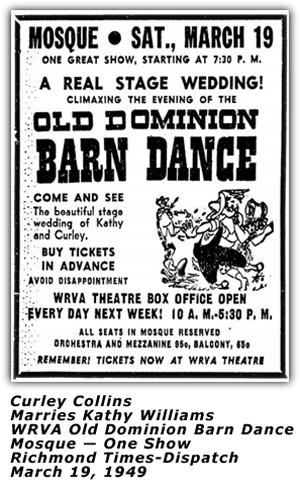 Sunshine Sue seemed to have a knack for promoting the show and generating interest. One such occasion
occurred in March 1949 when the show and WRVA promoted the on-stage "live" wedding of Ruey (Curley) Collins
to Kathleen (Kaki) Williams.
Sunshine Sue seemed to have a knack for promoting the show and generating interest. One such occasion
occurred in March 1949 when the show and WRVA promoted the on-stage "live" wedding of Ruey (Curley) Collins
to Kathleen (Kaki) Williams.
First there was a show themed around "Curley's Bachelor Party" on Saturday night March 12, 1949. It was also
billed as "Dallas Ketcham" night. Then, for the actual wedding, the show moved to the larger capacity Mosque
auditorium on March 19, 1949. There was to be only one show that night. Thus, the wedding was to be the featured
part of the program and would not be re-done. Country Music fans will recall that Hank Williams married Billie Jean Horton
on the KWKH Louisiana Hayride show twice in one day, but they had actually gotten married prior to those shows. The ticket
prices did not change for this special wedding night program.
One might notice who Best Man was at this wedding - it was Red Murphy, who was a comedian on the show. But since Curley
always worked with Benny Kissinger, one might ask where he was. Benny was actually playing the wedding music for the
ceremony. Curley did actually recruit Red for the barn dance cast. But after Red left the Barn Dance and started
working with Blaine Smith and the Atlantic Barn Dance, Red took exception to the fact that Curley did not also work with
him on the new show. Curley lost a good friend and was deeply distressed according to Curley's son, Phil.
The marriage lay the groundwork for a third show - the return from their honeymoon. That show was on March 26, 1949. That night,
the cast was to give the newlyweds a wedding shower.
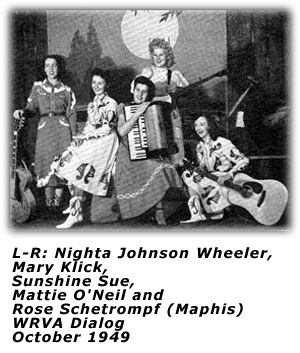 Since WRVA published weekly ads for the show from the beginning of the last great Sunshine Sue
era, let us take a look at how the "hillbilly" theme worked its way into the promotion of the show.
We will later see that even when Sunshine Sue tried to take the show to Broadway under
the name of "Hayride", the urban reviewers could not help but draw back on their perception and
bias about "hillbilly".
Since WRVA published weekly ads for the show from the beginning of the last great Sunshine Sue
era, let us take a look at how the "hillbilly" theme worked its way into the promotion of the show.
We will later see that even when Sunshine Sue tried to take the show to Broadway under
the name of "Hayride", the urban reviewers could not help but draw back on their perception and
bias about "hillbilly".
It can be seen in a couple of ways. The use of the term "hillbilly" in some way or in the terminology
or verbiage used in the ads to promote the shows. From a historical perspective, this show was
unique and set apart from other well known shows such as the WLS National Barn Dance or the WSM Grand Ole Opry,
which while appealing to a rural audience, did not push the "hillbilly" aspect as much.
Let us take a look at the terminology in the ads that seem to be "hillbilly" in nature.
- Button Buster and Britches Splitter
- Hee-haw like a mule in a cool pool at that fool—Crazy Joe!
- The Biggest Hill-Hollerin' Splinter-Kickin' Barn-Shaker You Were Ever On!
- Come On Down To The Barn Shakin' Hoe Down!
- Shingle Rattling Comedy Night
- Hitch Up and Drive Over! It'll Be A Splinter Kicker and a Shingle Rattler!
- Hitch Up Your Mule and Come Over!
- Prepare To Laugh With the Craziest Shindig and Shingle-Rattler You Ever Attended
- Hitch Up And Drive In For a Passle of Fun and Music!
- A Side-Splitter and a Button-Buster! A Stageful of Fun Not One Serious Second
- Whoopin' Holler School
- Saddle The Horses and Tune Up The Shootin' Irons!
- New Year Show—A Real Shingle Rattler
- A Bushel and a Peck of Fun and Music
- Girls: See the way the mountain gals throw the hitch on the fellers
- Boys: Study how to dodge the rope effen its too late
- Oh Brother! A Lallapaloosa of a show!
Then there is the use of "Hillbilly" in some way in the promotional ads.
- Genuwine "Russian Hillbilly"
- Genuwine "Siamese Twin" Hillbillys
- Genoowine French Hillbilly - Ooh-La-La and Wee-Wee
- Aahuabemehula The Hawaiian Hillbilly
- Hillbilly Tarzan With His Entire Family and "Screaming Meemie"
- Spotlighting Those Two Hillbilly Balladeers
- Hillbilly From Mars! He Arrives On A Flying Saucer!
- Queen of the Hillbillies
- Leap Year Night - Hilarious Hillbilly Wolf-Girls
- Hillbilly Wedding Night Plus Hillbilly Santa
- Hillbilly Easter Parade — The Most Egg-citing Show Ever
- The Hillbilly Who's Who
- Male Beauty Contest - Come And Vote For Your Favorite Hillbilly!
- Hillbilly Christmas Party—Crazy Kris Kringle Joe Maphis and the entire case welcome the Hillbilly Santa
- Beloved Hillbilly Lady of Song Back On The Stage
- Romance for a Hillbilly Valentine!
- Hillbilly Easter Parade
- Mr. Hillbilly of 1949
- Hillbilly Tarzan
- Hillbilly Holiday Doin's
- Rib-Tickling Tunes Everything In The Hillbilly Screwball Manner
- Songwriter's Night—Hear The Nation's Hillbilly Hits of the Future
- The One And Only Hillbilly Midget Band
- Santa Claus Workshop, Hillbilly Style
- Hillbilly Xmas Party!
- Happy New Year Party—You have fun! It's VERY informal! It's hillbilly!
- 17 Famous Hillbilly Stars Singing and Playing Their Way Into Your Heart
- Don't Miss the Irish Hillbilly Show
- America's Top Hillbilly Comic! (Quarantine Brown) Ugliest Man In Radio — He Says
- School Mam Sue and Her Hillbilly School Kids
- Hillbilly Goblins, Ghosts and Witches
- A Hillbilly's New Year's Show Tonight!
 Another aspect is to look at the milestones in terms of attendance that WRVA promoted
for the Old Dominion Barn Dance:
Another aspect is to look at the milestones in terms of attendance that WRVA promoted
for the Old Dominion Barn Dance:
- 100,000 — August 2, 1947
- 200,000 — July 3, 1948
- 300,000 — June 18, 1949
- 400,000 — September 30, 1950
- 500,000 — February 2, 1952
- 600,000 — August 1953 (not specifically mentioned; July 25 mentioned 594,368.
- 700,000 — ??
- 800,000 — January 14, 1956
In August of 1949, Red Murphy, known as a hillbilly comedian who also played the harmonica
and tap danced, celebrated his second anniversary with the show. But late in 1949,
a new, competing show arrives on the scene. The Atlantic Barn Dance.
The first ad for the show appeared on December 3, 1949. The show was held at
the Atlantic Rural Exposition Grounds. It advertised 3,000 seats and "new heat" along
with free parking. Admission prices were 50 cents for adults and 25 cents for children.
Frank Porter of WLEE's "Country Stars" was to be the Master of Ceremonies. Advertised
acts included Clyde Moody and His Carolina Woodchoppers, and, Smiley Wilson and His Range Pardners.
That first show was to be held Friday and Saturday nights.
The following week, there was only the one show on Saturday night. Red Murphy was now
the headline star of the show. Frank Porter was still emcee. Other names seen previously
on the WRVA show were Nita Lynn, Bill and Arlene. The show was promoting square and round
dances on a 'new floor surface' after the show with a veteran caller and set leader. In addition,
special buses were to run from 8th and Broad Streets to the Barn Dance starting at 7:00pm. Keep
in mind that the WRVA Theater was at 9th and Broad Streets. One can envision a bit of the large
crowds gathered in downtown Richmond and deciding which show to attend.
|
WRVA Old Dominion Barn Dance - 1950
|
|
The competition may have been pretty robust. The promotional ads for each show were larger than
past ads the WRVA show had used. Weekly ads for both shows were seen up until about July of 1950.
Had the Atlantic Barn Dance ended? In November of 1950, a new ad for the show was seen,
but the new headline act was "Brother Slim Williams". The ad mentions that "Brother" Williams'
comedy preaching is a riot and he uses a telephone directory and catalogue for his inspiration."
At the end of July 1950, the local newspaper was reporting that the WRVA Old Dominion Barn Dance had signed
Merle Travis to a lengthy contract. At the time, he was working with Cliffie Stone
on the Hollywood Barn Dance. He was to make his first appearance on the Saturday night show
on July 29, 1950. Jack Stone, theater manager of WRVA Theater, said Merle would fly back to
the west coast to wrap up his business then settle in. Mr. Travis indicated that Richmond suited him
just fine and wanted to trade a Hollywood bungalow for some ground in the area with a house on it.

But things did not work out for Mr. Travis and his tenure on the show was perhaps less than two months.
|
WRVA Old Dominion Barn Dance - 1951
|
|
The year of 1951 saw continued competition. But instead of from the Atlantic Barn Dance it was now simply
called Square Dance Hillbilly Show and headlined by Red Murphy.
The show was held at the Atlantic Rural Exposition Grounds. But the strain of continuing to operate
were being seen. The promotional ads were getting smaller and less elaborate. The ads also did not list
the other artists appearing on the show most of the time.
One exception was for the special Easter show. It mentioned that former Old Dominion Barn Dance members
such as Benny Kissinger, Joe Wheeler, Bessie Lou, Dallas Ketcham, Lennie Jones and Dewey Ritter
would be on the show.
Meanwhile during that first part of the year, the Old Dominion Barn Dance ads were featuring an
anniversary show for Sunshine Sue and Her Rangers, Grandpa Jones and Ramona, Fred Kirby from WBT,
the Carter Brothers and Sister, an anniversary party for Curley Collins and his wife Kathy (Kaki).
Then in mid-April the Atlantic Barn Dance resurfaces but at the Venus Theatre in Richmond
and a starting time of midnight, perhaps trying to capture the crowd leaving the WRVA Theatre.
The Atlantic Barn Dance moved back to the Atlantic Rural Exposition Grounds at the end of April
and started featuring some name acts such as June Carter, the Tobacco Tags, Mother Maybelle Carter.
During the research of this time period, there was a big promotional efforts for a Grand Ole Opry
show to be held at the City Stadium in Richmond on May 23. The show was to feature Hank Williams,
Hank Snow, Arthur (Guitar Boogie) Smith and the Duke of Paducah. But in an article the day, Edith Lindeman
noted that the audience was told by the Duke that Hank Williams would not be appearing that night. The Duke
also told the audience that if they were not satisfied with the show with Hank's absence,
they could get their money back. The Opry sent replacement acts that included Ernest Tubb,
Lonzo and Oscar and Moon Mullican. The show went on for three hours.
In June, Red Murphy's show moved to Gray's Armory in downtown Richmond. In the July 28 ad,
they told readers that they were "Richmond's Only Real Barn Dance". On August 30, the show
was to be at the Venus Theatre. If ads are an indication of its run, then if the show was
still being offered, there were no ads. The last ad seen was on October 13 for a show at the Grand
Theater at 11:30pm. It may have been the last show. For after that, the Old Dominion Barn Dance
promotional ads began to tout "Richmond's only stage show!".
In December, WRVA was promoting a holiday visit from Crazy Joe and Rose Maphis from California.
And one could not help but wonder what they meant in their December 29 ad when they promoted "A
Hillbilly New Year's Show".
|
WRVA Old Dominion Barn Dance - 1952
|
|
The September 1952 WRVA Dialog (a monthly publication) mentions that the Old Dominion Barn Dance
was on the CBS Network again the past summer and was under the sponsorship of Dr. Pepper.
The fifteen minute show was heard on Saturday mornings at 10:15am on 55 radio stations, mainly in the
south and southwest. The show was heard in Kentucky, Missouri, South Carolina, North Carolina,
Georgia, Tennessee, Mississippi, Alabama, Louisiana, Florida, Oklahoma, Texas and Arkansas.
The quarter hour show was recorded every Saturday night from the WRVA Theater where the show
was held, at 7:30pm and 9:30pm. Harry Monroe was the announcer for the network show while
Ray Kennedy was the producer and director.
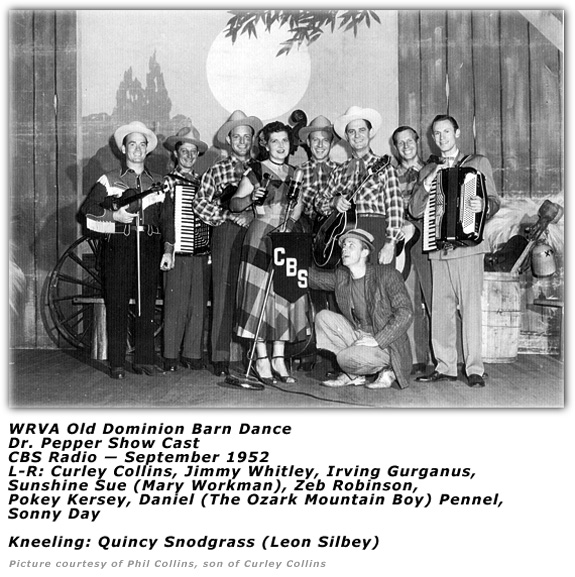
On Saturday night, November 8, 1952, the WRVA Old Dominion Barn Dance was broadcast on the CBS radio
network as part of a new series called "Saturday Night Country Style." The Richmond Times-Dispatch
told its readers that the new show had "...been set so as to originate in a number of the country's leading
hillbilly centers." The WRVA show in Richmond was selected to start the series. Six "live" programs
were to rotate each Saturday night. The November 7, 1952 article mentions that a subsequent broadcast
would occur on December 20, 1952. The network broadcast portion would occur during the second
show of the night between 10:30pm to 11:00pm.
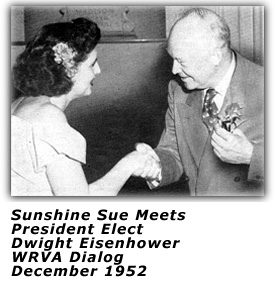 This article also states who the performers would be and the tunes they would perform. Sunshine Sue
would do "Smiles Are Made Out of Sunshine" and "Molly Malone". Zag (The Ozark Mountain Boy) Pennel would
do "Jambalaya". Benny Kissinger would do "Yodelin' Ranger" and Mary Klick would be making her
first appearance since her return from a USO trip to Korea. Sonny Day and his accordion would be
on the show as well as Lennie Jones and his guitar and Cousin Elmer with his harmonica.
This article also states who the performers would be and the tunes they would perform. Sunshine Sue
would do "Smiles Are Made Out of Sunshine" and "Molly Malone". Zag (The Ozark Mountain Boy) Pennel would
do "Jambalaya". Benny Kissinger would do "Yodelin' Ranger" and Mary Klick would be making her
first appearance since her return from a USO trip to Korea. Sonny Day and his accordion would be
on the show as well as Lennie Jones and his guitar and Cousin Elmer with his harmonica.
C.E. Butterfield, a radio columnist for the Associated Press (AP), was quoted as stating, "It was a pleasant
example of what this veteran program can supply under the guidance of Sunshine Sue Workman." Lester Gottlieb,
the vice-president in charge of Network Progrms for the CBS Radio Network was also quoted, "Thanks for
getting 'Country Style' off to a rousing start. Thought first show was top flight and will set high standards
for others to follow."
The six programs that would be in the weekly rotation of Saturday Night Country Style would be:
- The Old Dominion Barn Dance (WRVA - Richmond, Virginia)
- The WWVA Wheeling Jamboree (WWVA - Wheeling, West Virginia)
- The Louisiana Hayride (KWKH - Shreveport, Louisiana
- The Tennessee Barn Dance (WNOX - Knoxville, Tennessee)
- The Big "D" Jamboree (KRLD - Dallas, Texas)
- The Old Kentucky Barn Dance (WHAS - Louisville, Kentucky
The show gained in popularity and CBS gave it even more exposure. In April 1953, the show would
be featured on the CBS network twice a week (Tuesdays and Thursdays) at 3:45pm. The "live" network
broadcast would be played later over WRVA at 5:30pm the same day.
|
WRVA Old Dominion Barn Dance - 1953
|
|
The Old Dominion Barn Dance not only got recognition from being on
the network, but also from several magazines. In 1950, "Radio
Album" gave them an award for "Outstanding Contribution to American
Folk Music in Radio and Theater Entertainment". In 1952, "Who's Who in TV & Radio"
magazine (published by the Dell Publishing Company) highlighted her with a picture and biography
among hundreds of radio personalities. She was the only radio person from Virginia cited.
The WRVA Dialog of November 1952 reports that the show was featured in Part III of a "First Road of the Land"
which traced Route 1 from Washington, DC through Georgia. A 500 word portion devoted to Richmond
in featured Sunshine Sue and the barn dance show.
Last, but not least, each week, a half of the show was recorded on tape,
then flown from Westover Air Force Base in Massachusetts to Africa where
it was then re-broadcast via the Armed Forces Radio Service network.
In June of 1953, Fred Rose of the Acuff-Rose Publishing Company and Howie Richmond
made a trip to Richmond to record sides with the Westernaires and also with Sunshine Sue.
The recordings were released on the Decca record label. On June 28, 1953, Edith Lindeman
told readers of a recording session by Sunshine Sue in her article, "Sunshine Sue and Westernaires
Work Hard For Day of Recording Their First Folk Ballads".
One of the songs recorded was "Blackberry Winter". Ms. Lindeman wrote that the tune was given a thorough analysis
"...before that canny song-doctor Rose got through with it. He took the first two verses and pulled out the first
lines of each to make one verse. She quoted Rose, "I couldn't get the song out of my mind, but it worried me because it
took too long to get to the point. You have to hit the main theme right off if you want to sell records."
Readers learned that Sunshine Sue had made the recordings in a four hour session the previous week.
The songwriter credits for "Blackberry Winter" on Decca Records 29156 were Edith Lindeman and Carl Stutz. So while
Fred Rose seemingly did some magic with the composition, he did not take any songwriter credit on the song. But Ms. Lindeman
did not tell readers she was one part of the songwriting team. Further research shows that she was co-writer again with Carl Stutz
of Willie Nelson's "Red-Headed Stranger".
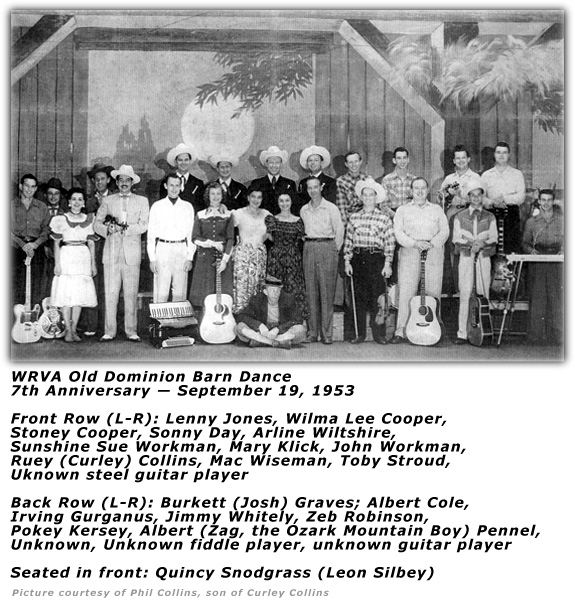
In late 1952, the Atlantic Barn Dance was born again. It was again at the Atlantic Rural Exposition Grounds.
But this time, the headline act was Bob Williams and his Cumberland Mountaineers. The show was
also being broadcast over radio station WRNL from 7:30pm to 8:00pm. Bob got his start on radio station
WLBJ in Bowling Green, Kentucky in 1942. In 1944, he formed the Cumberland Mountainners which
at that time included Eddie Ford on fiddle, Slim Binkley on guitar, Delbert (Pee Wee) Williams on hawaiian guitar,
Jimmy Williams on the mandolin and Major Owens on bass. They were hired by radio station WJZM in Clarksville,
Tennessee. but World War II interrupted the band's career. Bob got out of the service in late 1946. Upon
return to civilian life, he put the band back together. But this time J. W. Gower was now on bass
and Johnny Wayne on accordion. The band went to WKDA in Nashville, then joined the staff of WLAC in 1947. In 1948,
he was working in the east coast area.
 The ads this time for the show were not as flashy as the previous version of the show. In fact, this new
version seemed to sputter a bit as in March of 1953, the show was being held at the State Fairgrounds
but the ad did not mention Bob Williams nor was it being broadcast.
The ads this time for the show were not as flashy as the previous version of the show. In fact, this new
version seemed to sputter a bit as in March of 1953, the show was being held at the State Fairgrounds
but the ad did not mention Bob Williams nor was it being broadcast.
But Bob and the Cumberland Mountaineers were still in Richmond and were playing a stage show
at the Grand Theater which was being touted as a "Hillbilly Jamboree" that included Joe Binglehead (Jimmy Williams).
The Atlantic Barn Dance had disappeared from the ads again.
The Grand Theater then seemed to start featuring a new stage act each Saturday, but the show
was held at midnight, perhaps with the intent to capture the audiences that were leaving the
Old Dominion Barn Dance or other shows in downtown Richmond.
But from June 1953 through the end of October 1953, there were no further promotional ads for the Grand Theater
shows featuring stage acts.
But on November 7, 1953, the Atlantic Barn Dance would again rise up and feature Bob Williams and his Cumberland
Mountaineers along with Joe Binglehead re-emerged at the Atlantic
Rural Exposition Grounds, with portions of the show to be broadcast over WRNL.
|
WRVA Old Dominion Barn Dance - 1954
|
|
Research of this program shows that sometime in 1954, a pair of brothers who called themselves the Newton Rascals
appeared on the barn dance. The brothers were natives of Richmond and at the time were nine and eleven years old.
They were Wayne Newton and Jerry Newton. By summer of 1954, they working with Bob Gallion and being heard over WCLT
out of Newark, Ohio. A few years later, the family moved to Phoenix, Arizona. The boys were then calling themselves
the Rascals of Rhythm.
September 1954 - The Barn Dance Goes To Broadway
The local Richmond newspaper told readers of the upcoming events for the Old Dominion Barn Dance.
That weekend, of September 10, 1954, the show was going to celebrate its Eighth Anniversary under the guidance
and leadership of femcee Sunshine Sue. But on the following Monday, the premiere of "Hayride" was to occur
on Broadway in New York City.
At that time, the WRVA Old Dominion Barn Dance was one of six shows alternating each week on the "Saturday Night
Country Style" radio program heard coast-to-coast on the CBS network. The Richmond newspaper notes that in the decade prior
to this, "...hillbilly music has come out of the hills to ramble around the big cities and kick up its heels on
all musical best-seller lists...". It further noted that the trend was so big that the U. S. Congress had designated
May 26 as the annual National Hillbilly Music Day.
It was reported that the first night was sold out and there were solid ticket sales in the week following the opening.
The New York Times announced to its readers on September 12, 1954 that on September 13, 1954
at the 48th street theater, a "hillbilly show with a cast headed by Sunshine Sue" was to open.
Curtain time was 8:00pm.
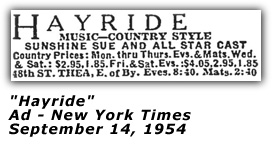 On September 13, a J. P. Shanley wrote of this new show in his "Hot Time Tonight For 48th Street"
column. The show was called "Hayride"; he put it simply that its premise was to be a hillbilly
folk musical (he indicated that he would describe it in 'ordinary language' - showing once
again the disdain urban reporters had for such shows. He indicated the show was sponsored
by Barron Howard and Jack Stone. The cast would include 25 performers led by Sunshine Sue.
On September 13, a J. P. Shanley wrote of this new show in his "Hot Time Tonight For 48th Street"
column. The show was called "Hayride"; he put it simply that its premise was to be a hillbilly
folk musical (he indicated that he would describe it in 'ordinary language' - showing once
again the disdain urban reporters had for such shows. He indicated the show was sponsored
by Barron Howard and Jack Stone. The cast would include 25 performers led by Sunshine Sue.
So, what price did the urban audience pay to see "Hayride"? The ad included here shows that prices
were $2.95 and $1.85 per seat for matinee performances (at 2:40pm) on Wednesdays and Saturdays as well as evening
performances Monday through Thursday. For Friday and Saturday evening performances at 8:40pm, prices
were $4.05, $2.95 and $1.85. Per the show's ad in the New York Times, there were shows
Monday through Saturday in the evening at 8:40pm. Matinee shows were held at 2:40pm on Wednesdays and Saturdays.
The writer tried to inject humor into his article written for the New York City urban dwellers
telling them that "pickin' and singin' is a 'term' for a musical performance. Then a 'shingle lifter'
was a lively party.
The author notes that the "Hayride" would use material "...that originates in the Southern hills,
the Western plains, bayous, plantations and crossroad stores."
On September 14, 1954, the New York Times reviewed opening night.
The article lists the cast which included:
- Sunshine Sue
- Cousin Joe Maphis and Rose
- Lester Flatt and Earl Scruggs
- Foggy Mountain boys (Paul Warren, Jake Tulloch, Curly Sechler)
- Coon Creek Girls (Lily May, Rosie and Black-Eyed Susan)
- Trail Blazers (Ray SMith, Roy Horton, Johnny Newton)
- Eddy (Texas) Smith
- Quincy Snodgrass
- Mary Klick
- Zeb Robinson
- Sonny Day
- Fiddlin' Irving
- Zag (The Ozark Mountain Boy)
- Gene Jenkins
- Jody Carver
The writer of the review kind of indicates a bias when we read "...The whoopin' and hollerin',
however, were not for a masterwork of the drama by a newly discovered genius but rather for the pickin' and
singin' of a hillbilly musical revue called "Hayride".
Then the reader is told that the performers on stage seemed to enjoy the renditions by their fellow
performers to the extent as if it were the first time they had seen and heard them. The writer further
comments, "Indeed, it is doubtful whether a band of more informal and earnest entertainers ever has graced
a local professional stage."
But the writer then seems to get into more of an objective analysis of what was seen and heard.
Each performer seemed to "...do just about anything with a mandolin, guitar, harmonica, bass fiddle, fiddle
or accordion."
But the one that got his attention was Cousin Joe Maphis who was described as a "tall, pleasant-mannered fellow".
Joe played a half dozen instruments but his trick fiddling was such that it could "...make a city slicker's eyes pop."
The writer observed Joe played the fiddle (note the term fiddle and not violin) under his chin,
under his arm, on his back, under his legs and just about any way a human could pull the bow.
Sunshine Sue did "some pleasant ballads". But Lester Flatt and Earl Scruggs backed by the Foggy Mountain Boys
"...couldn't do anything wrong as far as the balcony was concerned..."
The reviewer concluded his review with this comment: "Reckon those folks who like this sort of thing
ought to get themselves over to the Forty-Eighth Street Theatre. This "city square" although not
unreceptive to hillbilly music, found a full evening of it somewhat enervating."
One of the national columnists, Dorothy Kilgallen, wrote a condescending sarcastic few paragraphs
about the show before it even opened. In her syndicated column that appeared in newspapers across the country,
one headline seen was "You'd Better Head for the Hill, Billy" in an Indianapolis, Indiana newspaper.
She notes in her first paragraph:
"For New Yorkers who cannot abide corn except on the cob, the most frightening event of the
theatrical season will occur September 13 when a divertissment called "Hayride" — described
as the first hillbilly show ever to open on Broadway — arrives from Richmond, Va., and settles
into the 48th Street Theater."
"On opening night the playbill will strive to assist the uneducated by providing a glossary of
hillbilly terms (Example: a chili dipper is a ukulele and a mandolin is a tater bug) and as if
that were not enough to curl your toes the whole proceeding will be m.c.'d by a gal known as
Sunshine Sue."
She went on to sarcastically note that the musicians played without musical score because they play
their instruments by ear "...and couldn't read the music sheets if there were any." In another
version of the column, a Dayton, Ohio newspaper she says, "It has not been announced, but presumably
there will be a dramamine concession in the lobby." One supposes she was writing to her city slicker
audience in that particular column.
Billboard published an editorial column in its September 4, 1954 issue entitled "Misguided Columnist" offering
a rebuttal to Ms. Kilgallen's column.
"To use the words of the late Hank Williams: 'Hey, Good Looking!'
In this way might Williams good-naturedly blow the whistle on columnist Dorothy Kilgallen who this week
drew a bead on country music. Commenting on the expected arrival of "Hayride" at the 48th Street Theater, Miss
Kilgallen calls this a 'frightening even to New Yorkers, who cannot abide corn except on the cob.' In succeeding
paragraphs Miss Kilgallen by crude attempts to belittle the country field, succeeds wonderfully well in highlighting
her own snobbism and ignorance.
For only the iignorantcan be unaware of the important contribution country music has made to American entertainment,
and—in a larger view—to American culture. And only a snob could suggest that the performance of "Hayride"
would be alleviated by a dramamine concession in the lobby.
The scheduled advent of Sunshine Sue and company at the 48th Street Theater is not frightening. It will either prove
a flop or a success. What is frightening is Miss Kilgallen, who, despite her years of exposure to show
business, can yet express with such consummate bad taste her lack of knowledge of one of its major forms."
The Playbill web site indicates the show opened September 13, 1954 and closed on October 2, 1954 after
24 performances. Perhaps the timing of the show was good. On August 23, 1955, the theater
suffered damage when a 10,000 water tank fell through the roof. This was seen in a news photo
for auction on eBay.
The New York Times reported in August 1955 that the wooden water thank fed the fire sprinkler
system and stood atop a similar tank that provided the regular water for the theater. Both tanks
were mounted on the roof over the stage. The orchestra pit and first seven rows of seats were
destroyed and the roof had a 50 by 100 foot hole. The article noted that about 200 of the theater's
917 seats were destroyed. The theater had opened in 1912.
A week later, Sam Zolotow reported in the New York Times that due to the extent of the damage,
the site was potentially going to be turned into a parking garage. The theater was under the
control of the Joseph Leblang estate which was represented by three daughters. The sisters
were said to have had a "theatrical heritage" and were not ready to part with the property. But
the offers were perhaps too good to ignore. The insurance money would not have been enough to
repair the theater and also increase seating capacity to improve bookings. But a theater contractor
who was willing to help noted that there was not enough room to enable any proposed expansion
for seating.
Zag Pennel garnered quite a bit of publicity from his Broadway appearance. A syndicated columnist
named Inez Robb wrote a feature about him that was carried in many newspapers around the country.
But what was interesting was the different column "headlines" that newspapers used to publish
Ms. Robb's column. Some examples:
- Zag, Hillbilly With A Song
Detroit Free Press (Sep 24)
- Ozark Mountain Boy is Broadway's Latest Idol
Daily News (Lebanon, PA) (Sep 25)
- Ozark Hillbilly Lights Broadway Horizon
Austin American-Statesman (Sep 24)
- Broadway's New Idol
Clarion-Ledger (Jackson, MS) (Sep 24)
- Broadway's Hog-Wild Over Hillbilly Who's "Pure Pleasure" on Stage
Miami News (Sep 24)
- Alright, Let's Face It Zag's New Matinee Idol
News-Journal (Mansfield, OH) Sep 26
- New Broadway Idol Is Boy From Creek in Ozark Hills
El Paso Herald-Post (Sep 25)
- Zag, Ozark Mountain Boy, Current Flash On Broadway; But Can't Stay Up Late
Honolulu Advertiser (Sep 27)
One cannot omit how this show was sold or presented to the audiences attending the musical.
The Playbill for the show tries to define the type of music and its roots to the urban audience.
On the one hand it says it is the first musical to bring "new folk music in the making and the old folk
music which has stood the test of time."
From the Playbill for the Hayride, "The Genesis of the 'Country Style' Musical":
"The people of the mountains were more dependent on their own resources than those on the rivers and plains
because of poorer communications. Due to this isolation, they preserved more of their forebears' (English)
songs, and contributed more of their own. This, of course, is where the term "Hillbilly" enters
into the picture.
The true hillbilly musician is an untrained entertainer, usually both an instrumentalist and a vocalist.
As a rule, he writes his own songs about the things he experiences and the events he's heard about, or interprets
the songs other hillbillies have composed. It is rare indeed if he has any formal knowledge
of music or verse form. He is, in every sense a 'primitive' ".
Sidebar: Abbie Neal and Her Ranch Girls
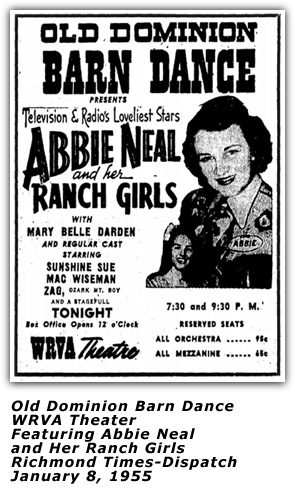 But is the story of the run on Broadway over? In January 1955, it was announced that Abbie
Neal and Her Ranch Girls were going to join the cast of the Old Dominion Barn Dance.
Abbie's group had just returned from an overseas tour in Greenland. But the January article
also told readers that Sunshine Sue had auditioned the group in August of 1954. She was so
impressed, she signed them to appear in the "Hayride" musical on Broadway. It was stated that
their popularity in that show prompted Sue to invite the group to join the WRVA cast as soon
as their schedule allowed it. The Playbill listing of the cast does not mention Abbie Neal and
her Ranch Girls at all. The review of the musical by the New York Times does not mention them. The local
Richmond newspaper provided a story of the show opening, but was based on wire service
reports and did not go into cast details. An October 1954 Billboard article mentions that her
group had recently visit Wonderland Ranch in Ontario, Canada.
But is the story of the run on Broadway over? In January 1955, it was announced that Abbie
Neal and Her Ranch Girls were going to join the cast of the Old Dominion Barn Dance.
Abbie's group had just returned from an overseas tour in Greenland. But the January article
also told readers that Sunshine Sue had auditioned the group in August of 1954. She was so
impressed, she signed them to appear in the "Hayride" musical on Broadway. It was stated that
their popularity in that show prompted Sue to invite the group to join the WRVA cast as soon
as their schedule allowed it. The Playbill listing of the cast does not mention Abbie Neal and
her Ranch Girls at all. The review of the musical by the New York Times does not mention them. The local
Richmond newspaper provided a story of the show opening, but was based on wire service
reports and did not go into cast details. An October 1954 Billboard article mentions that her
group had recently visit Wonderland Ranch in Ontario, Canada.
Not wanting to leave any stone unturned, further research revealed another newspaper article
about Abbie Neal in this Broadway series. Harold V. Cohen wrote in his "The Drama Desk" column
in the Pittsburgh Post-Gazette on September 27, 1954 that the group was to appear in the show
starting September 27, 1954, a Monday. But due to a previous contractual obligation, they were flying
back to Pittsburgh to appear at the Daughters of America banquet. Mr. Cohen stated that is the
only way they would agree to appear in the Broadway production and still be able to fulfill
their commitment. Based on research, the musical closed on October 2, 1954, likely meaning that
Abbie Neal and Her Ranch Girls did not fly back to New York.
WRVA and Sunshine Sue went all out to promote the arrival of Abbie Neal and Her Ranch Girls.
One local item of note related to the group was that one of the members, Mary Belle Darden,
was from Portsmouth, Virginia. The weekly promotional ads were very different than other
Barn Dance ads and featured Abbie's group as the headline act.
WRVA advertised a good-bye show for Abbie and her group for the February 26, 1955 show.
But research shows the group was brought back by popular demand for the April 2, 1955 show. She also did
five more weeks in 1956.
As a point of observation, was this show ahead of its time, doing something different that other
shows were not doing? First, take into account that the show was led by a female star for several years,
going back to 1946, at least three years before Kitty Wells started recording. Then, in early
1955, the show doubles down and features another female headline act, an all-female band at that
with Abbie Neal and Her Ranch Girls.
|
WRVA Old Dominion Barn Dance - 1955
|
|
In 1955, history sees the show is on the down hill of its run with Sunshine Sue. The weekly ads
continue, but one starts to see a shift. New acts are advertised in the ads throughout the year.
The names seem more bluegrass oriented. Acts such as The Stanley Brothers (March), Carl Story and His Ramblin' Mountaineers (April),
Charlie Bailey and his Happy Valley Boys and Girls (March), Hack Johnson (May),
Ray Morris and the Morris Family (June), Mitchell Sisters (June), Buz Busby and his Bayou Boys (July),
The Cavaliers Quartet (November), and Curley Howard and the Farmhands (November).
But the ads show some shift in how the show was to be promoted. A September 10, 1955 ad touts "Virginia's Famous
Folk Music Show." But the October 15, 1955 ad shows "Music and Fun—Hillbilly Style". An add from October 22, 1955
touts "A shingle Rattler and A Splinter Kicker ... More Fun Than a Corn Shuckin'".
Some of the new acts that were showing up became popular enough to become seemingly permanent members
of the cast. Mac Wiseman and his Country Boys and Don Reno and Red Smiley and the Tennessee Cutups were
two such acts. In fact, Reno and Smiley would have another link to the show's history when they began another
version of the show for WRVA in 1957.
Porter Wagoner made a guest appearance on the show. Other Opry acts such as The Carlisles, Hawkshaw Hawkins,
and Arlie Duff also appeared as guests.
Mac Wiseman stayed with the show for several years and had a morning show as well. A July 1955 article indicated
he was quite popular while at WRVA. During one morning broadcast, he told listeners he would send them a picture
upon request. Mac got over 2,350 responses.
Don Reno and Red Smiley joined the cast and they brought the Tennesse Cut-Ups with them. The Cut-Ups were
Mack Magaha, who played fiddle, and John Palmer, who played bass. The act also provided some comedy routines
as well. Mack and John were known as Jeff Doolytater and Mutt Highpockets. Reno and Smiley would participate
in comedy roles as Chicken Hot Rod and Pansy Hot Rod.
Jim Wilson was also part of the show for a time. Jim had spent three years in Nashville on Eddy Arnold's "Checkerboard Jamboree"
show. He then moved to Orlando, Florida after getting his health back and began writing poems. One he wrote in tribute
to Thanksgiving was called "Thank You Lord For The Dinner" and did it as a recitation over the air. Response was such
that he did more and he recorded one with his daughter for the Mercury label called "Daddy, You Know What?"
In a December 1956 article that featured Jim, we also learn a bit of the inner workings of the show. The article
mentioned Jim liked getting back to his role on the show due to the efforts of Burt Repine. The article stated
that it was Burt's, "...understanding guidance, and his intelligent and even-tempered handling of details, all shows
flow smoothly and everyone is always in a happy frame of mind."
Janis Martin caused quite a stir with audiences and some articles suggested she was another "Elvis".
She started performing at an early age and had her own show over station WHEE in Martinsville, Virginia. By the time
she was 15 years old, she had her own stage show at the Realto Theater in Danville, Virgnia. That got WRVA's attention
and she then became the youngest member of the cast when she joined the show.
Sidebar: Did Elvis Appear on the Old Dominion Barn Dance?
In 1955, a young singer was touring with Grand Ole Opry acts such as Hank Snow and His Rainbow Ranch Boys
and Cowboy Copas. His name was Elvis Presley. On Monday, May 16, 1955, a show was at the Mosque.
The headline act was Hank Snow. Other acts on the bill were Martha Carson, Slim Whitman,
Davis Sisters, Onie Wheeler and Jimmie Rodgers Snow. The same show was held at the Municipal Auditorium
in Norfolk, Virginia on Sunday, May 15, 1955. On Tuesday May 17, 1955, the troupe was in Asheville, North Carolina.
Elvis was to return to Richmond in September 1955. He was booked on another "Grand Ole Opry" show at the WRVA Theater
on Sunday, September 18, 1955 for shows at 2:30pm and 8:30pm. The ad promoting the appearance shows how the billing
had changed. The Louvin Brothers and Cowboy Copas received top billing, but Elvis is now shown as "Special Guiest" and his
picture is included in the ad along with the hit records he had up to that time. A photo in the September 11, 1955
Richmond Times-Dispatch said that Elvis would '...head a country-singing show at the WRVA Theatre. One might say he performed on the 'stage'
where the Old Dominion Barn Dance was held each Saturday, but no clear cut evidence shows he actually appeared on the barn dance.
One would presume that if he did appear, a p;romotional ad would have mentioned his appearance.
The same show that appeared in Richmond on the 18th, moved on to Danville Fairgrounds in Danville, Virginia on
Tuesday, September 20, 1955.
On Saturday, June 30, 1956, Richmond music lovers had an interesting
choice. Appearing at the Mosque at 5:00pm and 8:00pm was a future legend, Elvis Presley and his stage show.
He was the sole act mentioned in the ad. At the WRVA
Theater, the barn dance show was holding fort with shows at 7:30pm and 9:30pm. Featured on the WRVA show,
were the Webster Brothers, Janis Martin, Jim Wilson, Reno and Smiley, Shirley Vaughn,
Zag of the Ozarks, Sunshine Sue and Bob Stone and the Green Valley Boys. One notices the staggered
show times. One also wonders, how many fans might have taken in both shows that day.
|
WRVA Old Dominion Barn Dance - 1956
|
|
January 1956 saw the return of Abbie Neal and her Ranch Girls for several weeks. Once again the ads for the show changed
to feature this guest star; the only other mention of an act on the barn dance was "Sue Presents..."
February 1956 saw once again the phoenix rising from the ashes, the Atlantic Barn Dance at the State Fair Grounds.
This time the headliner was Dewey Ritter. The show advertised "square and round dancing." Even that show started to feel the effects
of the onslaught of a new music era, for in March the show touted a "Rock 'n' Roll Night on the Atlantic Barn Dance." But by the
end of March, the promotional ads had stopped.
May seemed to be a Rock 'n' Roll invasion of shows that featured Bill Haley and the Comets,
The Platters, Bo Diddley. Another show headlining Carl Perkins, Johnny Cash, and Roy Orbison. Elvis returned on June 30.
Carl Perkins, Chuck Berry, Della Resse and others came to town on July 8.
During the summer, the Old Dominion Barn Dance brought in guest stars to help boost audiences. June saw an appearance
by Kenny Roberts. In July, several acts
from the Ozark Jubilee program appeared — July 7, Porter Wagoner; July 14, Sonny James and
on July 21, the Carliles. On August 25, Hawkshaw Hawkins and Jean Shepard guest starred followed by Arlie Duff on September 1.
In October, The Mosque once again featured Billy Haley and the Comets, Frankie Lymon and the Teenagers, Clyde McPhatter, The Clovers,
Chuck Berry and more.
The Old Dominion Barn Dance tried to stay in the competition as it featured Janis Martin at this time. But history
shows that musical tastes were changing with the arrival of a new kind of music.
June 1957 - Sunshine Sue Era of Old Dominion Barn Dance Ends
On June 8, 1957, Sunshine Sue would make her last appearance on the show that she had headlined
since September 14, 1946. Attendance had dwindled. Television was coming of age. The rock
and roll era was taking hold. The last show was to include Jim Wilson, Janis Martin,
Zag Pennell, Shirlee Hunter, Pete Pike and a group known as the Georgia Mountain Boys. The promotional
ad for that last show was a far cry from the creative, artistic ads that the show was known
for over the eleven year run. The local newspaper did not contain any feature article of Sunshine Sue
and her pending retirement from the show.
Maybe it is a piece of trivial information. But what were the ticket prices for the show at its start in 1946
compared to the show's wrap in June of 1957? Ticket prices as advertised in September 8, 1946 ad: Adults 60 cents;
children 30 cents. Ticket prices as advertised on February 13, 1957 ad: Orchestra 95 cents; mezzanine 65 cents.
The new version of the Old Dominion Barn Dance was to begin the following weekend on June 15.
The Richmond Times-Dispatch tried to drum up enthusiasm and even perhaps evoking
that rural hillbilly characterization by stating "...An entirely new cast
will do the singin' and pickin', the plunkin' and cavorting."
WRVA was bringing in Pee Wee King from Louisville and Little Eller Long ("...popular
in the hillbilly comedy set...")as the headline acts. An old familiar face would be returning
with the new cast, Red Murphy, who had spent a few years in Nashville on the Grand Ole Opry.
From Detroit, Casey Clark would bring his band. Finally the Blue Grass Champs from Washington, DC
would round out the cast.
Burt Repine was now the manager of the WRVA Theater. The June 1957 article stated that unlike the
past eleven years, each show was to feature a different headline act, brought in from around
the country. As for the presence of local acts, "...performers who have found favor with
local fans will be included in the lineup."
Apparently this new attempt did not go over well at the box office. One sees that a bit of the spirit
of the show was missing from the promotional ads for the new version of an old familiar show. Without
the audience connection to familiar faces each week, the show appeared to be just a package show of
touring acts coming through town for Saturday night. There was no show on Saturday June 29 that
we could find. But that did not mean this type of show would go away without future efforts
to find the old or maybe a new magic.
October 1957 — New Dominion Barn Dance Begins
 A few months went by without any shows being promoted. On October 18, 1957, an ad
for "Reno and Smiley's New Dominion Barn Dance" was seen, promoting a new
version of the show with some familiar names from the old show. The promoter of the show
it was later found to be Carlton Haney. It was going to be at the
WRVA Theater, but only one show from 8:00pm to 10:30pm. On the bill of performers
were Don Reno and Red Smiley and the Tennessee Cut-Ups, Pete Pike, Bill Haney and the Dixie Buddies,
Ronnie Reno and an act named "Chicken Hot Rod". Ticket prices were simple: adults 95 cents, children 50 cents.
It was advertised that it would be every Saturday night. The following week showed no ad,
but the WRVA radio programming listing on October 26 does show a half-hour broadcast
at 9:30pm for "Barn Dance".
A few months went by without any shows being promoted. On October 18, 1957, an ad
for "Reno and Smiley's New Dominion Barn Dance" was seen, promoting a new
version of the show with some familiar names from the old show. The promoter of the show
it was later found to be Carlton Haney. It was going to be at the
WRVA Theater, but only one show from 8:00pm to 10:30pm. On the bill of performers
were Don Reno and Red Smiley and the Tennessee Cut-Ups, Pete Pike, Bill Haney and the Dixie Buddies,
Ronnie Reno and an act named "Chicken Hot Rod". Ticket prices were simple: adults 95 cents, children 50 cents.
It was advertised that it would be every Saturday night. The following week showed no ad,
but the WRVA radio programming listing on October 26 does show a half-hour broadcast
at 9:30pm for "Barn Dance".
The show did not run weekly ads during this time. Some of the other performers listed in
other ads seen were Grandpa Jones and Ramona, Clyde Moody, the Blue Grass Champs.
Over the course of the year, Reno and Smiley left the show, but came back for its second
anniversary in October 1959. Ads that appeared featured Carlton Haney's name in early August 1958.
By then the cast had grown to 40 performers and the show would usually bring in Grand Ole Opry
stars for guest appearances.
Some of the cast members in 1959 were Dewey Ritter, the Country Cavaliers, the Cripple Creek Boys,
Gene Boggs, Chief Powhatan, Donna Gaye, Rusty (Koko the Hobo) Adams, the Trailblazers, Joe Stone and Bobby Adkins, and,
the Mitchell Sisters.
In 1961, the WRVA Theater was reverting to its previous name as the Lyric Theater. The non-profit
group, Old Lyric Theater Corporation, was going to operate the show. Burt Repine was said to stay
on as manager of the theater. The theater was owned at that time by the Life Insurance Company of Virginia.
The goal of the new corporation was to provide a venue for local groups to perform. But the group
would also try to bring in touring companies with professional plays. The theater would also
undergo refurbishing and redecorating.
It is not our intent to cover in too much more detail about this "New Dominion Barn Dance".
This research effort was primarily focused on WRVA, its growth as a radio station, the use
of "hillbilly music" in its programming and its early and continued efforts to develop a live
'barn dance' show.
The most successful of those attempts was when Sunshine Sue embarked
on the show starting with the premier at the WRVA Theater on Saturday night, September 14, 1946 and its run
through Saturday night, June 8, 1957. Doing the math, the show was aired 561 Saturday nights during that time
period.
Sunshine Sue would enjoy one last bow on the stage of the Old Dominion Barn Dance. She had retired in 1963,
but on March 23, 1975, she would grace the stage one last time for two shows. Some of the familiar acts would
grace the stage with her that day - Mother Maybelle Carter (along with daughter, Helen and three grandchildren), Grandpa Jones with
his wife Ramona, as well as Joe and Rose Lee Maphis. Her daughter
who had become known as Sunshine Sue Jr. (Ginger Workman Stanley) was the master of ceremonies for the show. In fact,
Sunshine Sue said that what got her to appear this one last time was Ginger. "Whatever Ginger wants, she gets, if I can
possibly do it."
Original cast member Irving Gurganus was said to be a committee of one to roundup many of the old-timers who had worked
with Sue over the years.
Other former cast members who were on the show included Curley Collins, Buster Puffenbarger who performed with three of his daughters
as sisters Bonnie and Bee could not be there, Benny Kissinger, Mary Klick, Pokey Kersey, Zeb Robertson, Lennie Jones, John Workman and Sam Workman.
One of Nashville's legends was also there on stage, Ernest Tubb, appearing with Ernest Tubb, Jr.
One of the highlights of the show was Ginger (Sunshine Sue Jr.) getting to perform on stage with her mom and dad for the first time.
The show closed with all the performers doing three songs, "Auld Lang Syne", "For She's a Jolly Good Fellow" and "You Are My Sunshine."
The reception she got touched Sue. She got a standing ovation and the audience sang along on the last two tunes. She said:
"To me, it was one of the happiest days of my life . . . it was just wonderful — a wonderful reception. I really
can't get over it. I got a little weepy there at the end, but I loved every moment of it."
On June 13, 1979, Sunshine Sue's life came to end due to complications of a heart attack at the age of 67. She was born Mary Arlene Higdon and married
her childhood sweetheart John (Sugarfoot) Workman at the age of 17.
Her death closed a chapter in country music (or can we say hillbilly music) history. She was unique in that she was a female who led a weekly, live
barn dance show for over a decade. The show was heard coast to coast over the CBS network. She used that network broadcast to lobby
for a congressional declaration of National Hillbilly Music Day that became the Memorial Celebration to Jimmie Rodgers. Country Music
Hall of Famers graced the stage of the Old Dominion Barn Dance. Her husband, affectionately known as Sugarfoot, died
in 1986. Both are buried in Hanover, Virginia.
Curtain Call
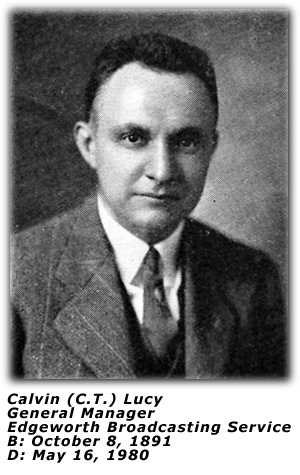
C.T. Lucy was instrumental in obtaining the lease for the Lyric Theater in Richmond. The theater
was renovated and renamed the WRVA Theater. This then became the home for the WRVA Old Dominion Barn Dance
starting on September 14, 1946. |
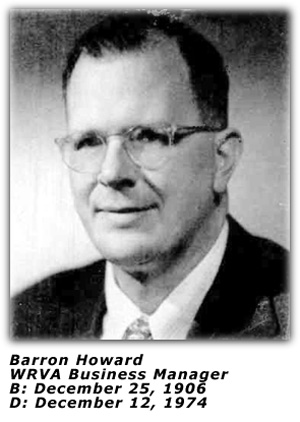
Barron Howard worked with Jack Stone when WRVA took over the Lyric Theater and worked to book
not only the WRVA Old Dominion Barn Dance program on Saturday nights, but other theater and stage
attractions. Hit Broadway plays were brought to the theater.
|
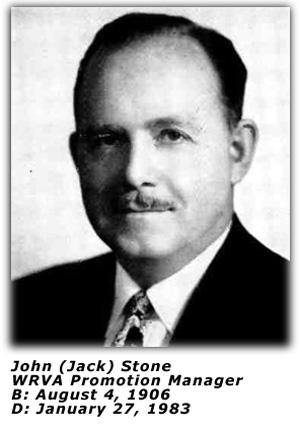
As promotion manager for WRVA, he and Barron Howard worked to develop the business for the WRVA Theater
when it opened with the WRVA Old Dominion Barn Dance show on September 14, 1946. |
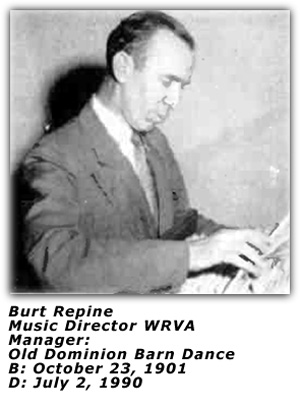
Burt Repine was the Music Director at WRVA. In addition, he had his own orchestra over the years
that performed in the Richmond area. He became the program manager of the Old Dominion Barn Dance.
He was also the manager of Janis Martin, Shirlee Hunter and other artists. During the run of the New Dominion Barn Dance,
Burt was the manager of the theater as he was for many years at the Lyric and WRVA Theaters.
|
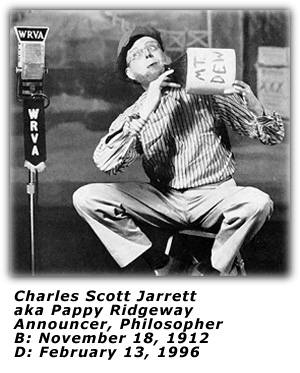
Scott Jarrett was a reporter, announcer and said to manage one of the Old Dominion Barn Dance radio shows.
He also was active locally and research has shown he produced stage presentations. He also played a character
known as Pappy Ridgeway and was said to be quite the philosopher. He had his own radio show in the early morning
on WRVA. |
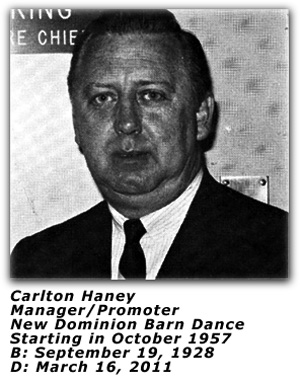
Carlton Haney was said to be recruited in the fall of 1957 to start the New Dominion Barn Dance on WRVA
along with (Don) Reno and (Red) Smiley. Carlton was their manager. He later took over the management of the show until 1964. On Labor Day weekend
in 1965,he is credited with starting the Bluegrass Festival concept at Fincastle, Virginia. He was inducted into the Bluegrass Hall of Fame in 1998.
|
Credits & Sources
- The News Leader; November 1, 1925; Staunton, VA
- The Bee; November 2, 1925; Danville, VA
- The Bee; November 3, 1925; Danville, VA
- The Bee; November 13, 1925; Danville, VA
- The News Leader; November 15, 1925; Staunton, VA
- Daily Press; November 29, 1925; Newport News, VA
- The News Leader; December 30, 1925; Staunton, VA
- The News Leader; February 20, 1926; Staunton, VA
- The News Leader; July 18, 1926; Staunton, VA
- Daily Press; August 12, 1926; Newport News, VA
- The News Leader; August 17, 1926; Staunton, VA
- WRVA Dialog; April 1940; Richmond, VA
- The News Leader; June 24, 1927; Staunton, VA
- The News Leader; August 10, 1927; Staunton, VA
- The Bee; February 2, 1928; Danville, VA
- The News Leader; August 10, 1927; Staunton, VA
- The News Leader; February 18, 1928; Staunton, VA
- The News Leader; April 28, 1929; Staunton, VA
- The Bee; August 22, 1929; Danville, VA
- The News Leader; October 23, 1929; Staunton, VA
- The News Leader; October 29, 1929; Staunton, VA
- The News Leader; November 13, 1929; Staunton, VA
- The News Leader; December 13, 1929; Staunton, VA
- The News Leader; February 7, 1930; Staunton, VA
- The News Leader; May 3, 1930; Staunton, VA
- The News Leader; November 25, 1931; Staunton, VA
- The News Leader; December 12, 1931; Staunton, VA
- The News Leader; April 1, 1932; Staunton, VA
- Richmond Collegian; November 13, 1933; Richmond, VA
- WLS Stand-By; October 17, 1936; Prairie Farmer; Chicago, IL
- The News Leader; October 17, 1936; Staunton, VA
- THe Bee; November 14, 1938; Danville, VA
- Daily Press; April 6, 1939; Newport News, VA
- Daily Press; March 16, 1939; Newport News, VA
- Richmond Times-Dispatch; November 8, 1939; Richmond, VA
- Richmond Times-Dispatch; November 16, 1939; Richmond, VA
- Richmond Times-Dispatch; November 18, 1939; Richmond, VA
- Richmond Times-Dispatch; November 23, 1939; Richmond, VA
- Richmond Times-Dispatch; December 2, 1939; Richmond, VA
- Richmond Times-Dispatch; February 5, 1940; Richmond, VA
- Richmond Times-Dispatch; Southside Supplement; February 17, 1940; Richmond, VA
- WRVA Dialog; April 1940; WRVA; Richmond, VA
- Richmond Times-Dispatch; February 20, 1941; Richmond, VA
- Richmond Times-Dispatch; February 27, 1941; Richmond, VA
- Richmond Times-Dispatch; March 1, 1941; Richmond, VA
- Richmond Times-Dispatch; March 8, 1941; Richmond, VA
- Richmond Times-Dispatch; June 14, 1941; Richmond, VA
- Richmond Times-Dispatch; December 6, 1941; Richmond, VA
- Richmond Times-Dispatch; December 13, 1941; Richmond, VA
- Richmond Times-Dispatch; December 20, 1941; Richmond, VA
- Richmond Times-Dispatch; January 3, 1942; Richmond, VA
- Richmond Times-Dispatch; April 11, 1942; Richmond, VA
- Richmond Times-Dispatch; August 29, 1942; Richmond, VA
- Cincinnati Enquirer; August 29, 1942; Cincinnati, OH
- Cincinnati Enquirer; December 30, 1942; Cincinnati, OH
- Billboard; 1944 Yearbook; page 96; Billboard; Cincinnati, OH
- Cincinnati Enquirer; August 29, 1942; Cincinnati, OH
- Richmond Times-Dispatch; August 12, 1943; Richmond, VA
- Richmond Times-Dispatch; November 20, 1944; Richmond, VA
- Richmond Times-Dispatch; November 21, 1944; Richmond, VA
- WLS Family Album 1944; Page 20; Prairie Farmer; Chicago, IL
- Cowboy Music World; March-April 1945; Frank Karpinski; Long Island, NY
- Richmond Times-Dispatch; March 22, 1945; Richmond, VA
- National Hillbilly News; August 1945; Poster Show Print Company; Huntington, WV
- Richmond Times-Dispatch; October 20, 1945; Richmond, VA
- Richmond Times-Dispatch; October 29, 1945; Richmond, VA
- Richmond Times-Dispatch; March 25, 1946; Richmond, VA
- Richmond Times-Dispatch; June 15, 1946; Richmond, VA
- Richmond Times-Dispatch; June 26, 1946; Richmond, VA
- Richmond Times-Dispatch; September 8, 1946; Richmond, VA
- Richmond Times-Dispatch; September 12, 1946; Richmond, VA
- Richmond Times-Dispatch; September 14, 1946; Richmond, VA
- Richmond Times-Dispatch; September 15, 1946; Richmond, VA
- Richmond Times-Dispatch; September 29, 1946; Richmond, VA
- Richmond Times-Dispatch; October 12, 1946; Richmond, VA
- Richmond Times-Dispatch; December 12, 1946; Richmond, VA
- Mountain Broadcast and Prairie Recorder; December 1946; Mountain Broadcast Pub. Co., Inc.; New York, NY
- Richmond Times-Dispatch; August 2, 1947; Richmond, VA
- Richmond Times-Dispatch; August 8, 1947; Richmond, VA
- Billboard; May 8, 1948; Billboard; Cincinnati, OH
- Richmond Times-Dispatch; October 18, 1948; Richmond, VA
- Richmond Times-Dispatch; November 22, 1948; Richmond, VA
- Jack Henderson's Song Book and Picture Album; 1948;
- National-Hillbilly News; March-April 1950; Mr. and Mrs. Orville Via; Huntington, WV
- Richmond Times-Dispatch; July 27, 1950; Richmond, VA
- Richmond Times-Dispatch; November 11, 1950; Richmond, VA
- Richmond Times-Dispatch; May 23, 1951; Richmond, VA
- Richmond Times-Dispatch; May 24, 1951; Richmond, VA
- Richmond Times-Dispatch; August 30, 1951; Richmond, VA
- Richmond Times-Dispatch; October 13, 1951; Richmond, VA
- Richmond Times-Dispatch; December 15, 1951; Richmond, VA
- Richmond Times-Dispatch; December 29, 1951; Richmond, VA
- Richmond Times-Dispatch; November 7, 1952; Richmond, VA
- WRVA Dialog; November 1952; Richmond, VA
- WRVA Dialog; December 1952; Richmond, VA
- Who's Who in TV & Radio; 1952; Dell Publishing Company, New York, NY
- Richmond Times-Dispatch; March 29, 1953; Richmond, VA
- Richmond Times-Dispatch; June 28, 1953; Richmond, VA
- Cowboy Songs; No. 35; July 1954; American Folk Publications, Inc. Derby, CT
- The Journal Herald; "Voice of Broadway - by Dorothy Kilgallen"; August 28, 1954; Dayton, OH
- The Indianapolis News; "You'd Better Head for the Hill, Billy" - by Dorothy Kilgallen"; August 30, 1954; Indianapolis, IN
- Billboard; September 4, 1956; "Misguided Columnist"; Billboard; Cincinnati, OH
- Richmond Times-Dispatch; September 10, 1954; "Old Dominion Barn Dance to Make Broadway Debut"; Richmond, VA
- New York Times; September 12, 1954
- Playbill; September 13, 1954; "Hayride"; New York, NY
- New York Times; September 13, 1954; "Hot Time Tonight for 48th Street"; J. P. Shanley; pg 19; New York, NY
- New York Times; September 14, 1954; Ad; New York, NY
- New York Times; September 14, 1954; 'Hayride' Has Premiere at the 48th Street; New York, NY
- Pittsburgh Post-Gazette; September 27, 1954; 'The Drama Desk'; Pittsburgh, PA
- Country Song Roundup; No. 35; November 1954; American Folk Publications; Derby, CT
- Richmond Times-Dispatch; January 5, 1955; "Abbie Neal's Ranch Girls To Join Barn Dance Cast"; Richmond, VA
- Richmond Times-Dispatch; January 8, 1955; Richmond, VA
- The Daily Press; May 15, 1955; Newport News, VA
- Richmond Times-Dispatch; May 16, 1955; Richmond, VA
- Asheville Citizen-Times; May 17, 1955; Asheville, NC
- Country & Western Jamboree; July 1955; Country & Western Jamboree, Inc.; Chicago, IL
- Richmond Times-Dispatch; September 8, 1955; Richmond, VA
- Richmond Times-Dispatch; September 10, 1955; Richmond, VA
- Richmond Times-Dispatch; September 8, 1955; Richmond, VA
- Richmond Times-Dispatch; September 11, 1955; Richmond, VA
- The Bee; September 17, 1955; Danville, VA
- Richmond Times-Dispatch; October 14, 1955; Richmond, VA
- Richmond Times-Dispatch; October 22, 1955; Richmond, VA
- Country & Western Jamboree; June 1956; Maher Publications, Inc.; Chicago, IL
- Richmond Times-Dispatch; June 30, 1956; Richmond, VA
- Country & Western Jamboree; November 1956; Maher Publications, Inc.; Chicago, IL
- Billboard; November 10, 1956; Billboard; Cincinnati, OH
- New York Times; August 24, 1955; "Water Tank Falls Through Roof of 48th Str. Theatre and
into Empty Seats"; New York, NY
- New York Times; August 31, 1955; "48th Str. Theatre Facing Last Act - by Sam Zolotow"; New York, NY
- Rustic Rhythm; Vol. 1 No. 2; May 1957; Rustic Rhythm, Inc. New York, NY
- Richmond Times-Dispatch; June 1, 1957; Richmond, VA
- Richmond Times-Dispatch; June 8, 1957; Richmond, VA
- Richmond Times-Dispatch; June 15, 1957; Richmond, VA
- Richmond Times-Dispatch; June 22, 1957; Richmond, VA
- Richmond Times-Dispatch; October 9, 1959; Richmond, VA
- Richmond Times-Dispatch; November 4, 1961; Richmond, VA
- Richmond Times-Dispatch; November 23, 1963; Richmond, VA
- Richmond Times-Dispatch; May 26, 1974; "Atkins New Book Has Local Overtones" by Norman Rowe; Richmond, VA
- Richmond Times-Dispatch; March 24, 1975; Richmond, VA
- Richmond Times-Dispatch; June 14, 1979; Richmond, VA
- Richmond Times-Dispatch; March 16, 1986; Richmond, VA
- The Old-Time Herald; "The Varied Musical Career of Slim Bryant—93 Years Young"; John Lilly; Fall 2002; Copy courtesy of Phil Collins
- Letter to Phil Collins from Hoyt Bryant; October 7, 2002; Copy courtesy of Phil Collins
- The “Voice of Virginia”: WRVA and Conversations of a Modern South; Caroline C. Morris; Dissertation; William and Mary University; Williamsburg, VA
- Country Music's First and Only Radio Barn Dance Femcee; 2015; Dr. Wayne W. Daniel; Presentation at International Country Music Conference; Nashville, TN
- Hillbilly-Music.com wishes to thank Phil Collins for his assistance and memories on this effort. He helped proofread, offer insight on the
promotional ads and kept us moving. He provided info on his dad initially (Curley Collins) and then it went from there.
- Hillbilly-Music.com wishes to thank Ray BOnis, Senior Research Associate of the Special Collections and Archives
for the VCU Libraries for providing us with copies of C. T. Lucy's papers showing the list of performers on WRVA
from 1925 to 1929.




